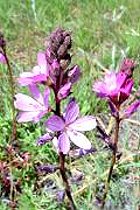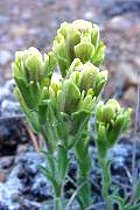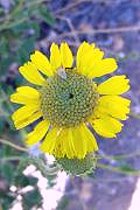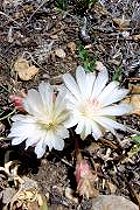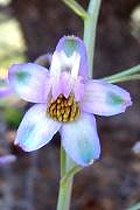-
pachy-: in compound words signifying "thick."
-
pachyacan'tha: thick-spined.
-
pachycar'pa: with thick fruits.
-
pachyle'pis: from the Greek pachys,
"thick," and lepis, "scale."
-
pachyphyl'la/pachyphyl'lus: thick-leaved.
-
pachypo'da: with a thick foot or stalk.
-
pach'ypus: thick-footed (or -stemmed).
-
pachysta'chya/pachysta'chyus: with a thick spike of some kind.
-
pachystig'ma: with a thick stigma.
-
pacif'ica/pacif'icum/pacif'icus:
from the Latin pacificus, meaning "peace-making, peacable,"
and from a botanic standpoint probably meaning "of the Pacific
Ocean or the general Pacific area."
-
packard'iae: named for Patricia Lois Packard (1927- ), botanical illustrator, professor of biology in the Department of Biology, College of Idaho, 1959-1989, co-author of Identification Key to the Common Native Evergreen Trees of Oregon. She received her BA from the College of Idaho, her MS from Oregon State University, and her PhD from Washington State University. She was instrumental in establishing the Idaho Native Plant Society, and was apparently a mentor to Barbara Ertter.
-
Pack'era: named for botanist John George Packer (1929-2019), specialist
on the flora of Alberta and on Arctic and
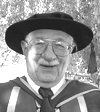 |
|
alpine flora, instructor
in the Department of Botany at the University of Alberta 1958-1988,
co-author with Cheryl Bradley of Checklist of the rare vascular
plants in Alberta (1984), one of the editors of the English edition
of Flora of the Russian Arctic (2000), co-author with his wife
of Some Common and Interesting Plants of San Miguel de Allende (Mexico). He also revised E.H. Moss's Flora of Alberta (1983),
worked to protect Mountain Park in the Canadian Rockies from an open-pit
coal mine, and was a contributor and on the editorial committee for Flora of North America. He was |
born in Reading, England, and after doing his compulsory national service obtained a BSc and PhD from the University of London. In 1957 he joined the Botany Department at the University of Alberta as professor and curator of the Vascular Plant Herbarium. He and his family built a log cabin on the sandhills northeast of Edmonton which was burned in the wildfires of 2008. One of his students, John Bain, described him as a "sometimes irascible old school gentleman with a penchant for big cigars [and] a humorous intellectual, generous with his time and knowledge." The genus Packera was published by Áskell Löve and Doris Benta Maria Löve in 1975. (Photo credit: Trinity Funeral Home, Edmonton)
-
padrecrow'leyi: named for Father John Joseph Crowley (1891-1940), called the
Desert Padre, naturalist, conserva-
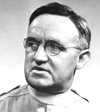 |
|
tionist, movie producer, storyteller
and first priest to celebrate mass on the summit of Mt. Whitney. The
following is quoted from one of Larry Blakely's superb articles in
his Who's
in a Name? series: "Though not a botanist, Crowley knew and
loved the native plants of the mountains and deserts. In his writings,
especially his weekly column "Sage and Tumbleweed" (which
he wrote using the pseudonym Inyokel), he frequently referred to the
plants that he admired on outings. He consulted the only book dedicated
at that time to the desert regions, Coville's "Botany of the Death Valley |
Expedition", published in 1893; Crowley called it
"the most complete survey of the flora of the valley extant".
Father Crowley, the "Desert Padre", struggled mightily,
and successfully, to enhance the economic base of the Eastern Sierra
in the 1930s, primarily by publicizing it as a tourist mecca. Like
Mary [DeDecker], he fought the City of Los Angeles over its water
policies, to help the disheartened residents out of their depression
over the City's depredations. His fatal auto accident occurred in
1940, when he was 48 years old. His legendary life and writings are
lovingly presented in the 1997 book, "Desert Padre", by
Joan Brooks. Prominent man-made features in the Eastern Sierra keep
the Crowley name alive: Crowley Lake; the Father Crowley Viewpoint
on the western approach to Death Valley National Park; a monument
on Highway 14 where he met his death in his old Ford (which, it is
said, he always drove too fast, hurrying to this or that secular or
religious appointment in his vast Eastern Sierra parish); and, recently,
a mural on a building in Bishop." And from the Catholic
Online website: " John J. Crowley was born on Dec. 8, 1891,
in County Kerry, Ireland. His family emigrated to Worcester in 1903.
Crowley entered Holy Cross in 1911 and became an active participant
in college life, contributing stories, essays and poems to The Purple
and serving as the journal's editor in chief during his senior year.
This literary flair would stay with him throughout his life as he
wrote for various local and diocesan publications during his 22 years
in California. After graduating from Holy Cross, he entered the seminary
in Baltimore, Md., with a reference from Rev. Joseph N. Dinand, S.J.
Ordained in 1918 in Fall River, Mass., he left shortly after for Los
Angeles, borrowing 50 dollars from his bishop to purchase his train
ticket to the coast. He served briefly in two parishes before he volunteered,
in 1919, to serve in a parish located in the desert region of four
different counties-Mono, Inyo, Kern and San Bernadino. His initial
parish covered 30,000 square miles, an area equal in size to all of
Ireland. His northernmost church was in Bishop, 200 miles from its
southern counterpart in Barstow. And in those years, this remote area
had few paved roads. Driving between his scattered parish meant bouncing
over gravel and sand. The parish contained both the lowest spot in
the United States, Death Valley, and the highest, Mount Whitney. In
his first 16 months, Fr. Crowley put over 50,000 miles on his Model
T Ford. Adapting quickly to his new environment, he kept a sleeping
bag in his car for emergencies and donned the uniform that would be
his trademark: riding boots, khaki riding pants and a khaki shirt
under which he wore his clerical collar. After serving in this desert
parish for five years, he became pastor of St. John's Cathedral, Fresno,
in 1924. During this time, Fr. Crowley was instrumental in starting
St. Columba's High School there; as part of a major diocesan fund-raiser,
he arranged for Babe Ruth and Lou Gehrig to appear in an exhibition
baseball game. Ten years later, Fr. Crowley returned to Eastern Sierra
County and the Owens Valley." It was what he found there that
caused him to dedicate a large part of his life to saving the Owens
Valley, all the while ministering to his parishioners in Lone Pine,
Bishop and Death Valley. Part of his attempt to publicize the region
was in the movies that were filmed in the Alabama Hills and the friendships
he forged with the likes of Cary Grant and Douglas Fairbanks, Jr.
More from Catholic
Online: "As part of his ongoing efforts to publicize the
Eastern Sierra as an ideal tourist location, Fr. Crowley organized
an extravaganza in October 1937. The three-day celebration entitled,
"The Wedding of the Waters," commemorated the completion
of a paved road from Death Valley to Whitney Portal, linking the lowest
spot in the country to the highest-in the then 48-state nation. In
a clever publicity move, Fr. Crowley filled a desert gourd with water
from the highest lake in the country. The gourd was carried first
by a Native American, then transported, on horseback, by one of the
first men to climb Mount Whitney. Next it was taken in a stagecoach,
driven by the descendant of an original stagecoach hand who was accompanied
by the governor of California. The gourd was passed along to a covered-wagon
driver who was a descendant of the ill-fated Donner Party, and then
handed over to the engineer of a narrow-gauge railroad. After a short
run on the rails, the gourd was passed to the driver of a new 1938
Lincoln Zephyr. At the end of this ride, President Roosevelt pressed
a telegraph key that sent word of the celebration to the rest of the
country. The Zephyr driver passed the gourd to a World War I combat
pilot who flew to Death Valley where the gourd was emptied into Bad
Water Sink, the lowest body of water in America. "The Wedding
of the Waters" was featured in papers across the nation, bringing
the publicity Fr. Crowley had sought. Recently, the Public Broadcasting
Company's Los Angeles affiliate sponsored a reenactment of the ceremony.
The widow of Hopalong Cassidy was present for the activities."
He was killed in 1940 when he car struck a steer on the road and collided
with an oncoming truck. Father Crowley no doubt is in the very top
ranks of the truly monumental characters of the Eastern Sierras and
Owens Valley region. (Photo credit: Explore Historic California)
-
Paeo'nia: named for Paeon, the physician of the
gods in Homer's Iliad who used the plant to heal the wound
that Hercules inflicted on Pluto. The genus Paeonia was published by Carl Linnaeus in 1753.
-
pahuten'sis: named for Pahute Mesa in Nye County, Nevada, this taxon
is rare in California, but may be found occasionally in the Grape
vine Mountains.
-
pajaroen'sis: of or from the area of the Pajaro Hills and/or Pajaro
Valley near Monterey.
-
palaesti'num: of Palestine. This is the black calla lily from the
Middle East.
-
Palafox'ia: named for José Rebolledo
de Palafox y Melzi (1776-1847), Duke of Saragossa, Spanish government
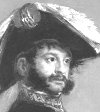 |
|
official, General, defender against the armies of Napoleon, briefly
Archbishop of Mexico, Viceroy of New Spain, book collector and author.
"Don José de Palafox y Melzi, Duke of Saragossa, the youngest
son of an old Aragonese family, was a Spanish General and hero of
the Peninsular War. Brought up at the Spanish court, he entered the
guards at an early age, and in 1808 as a Sub-Lieutenant accompanied
King Ferdinand VII of Spain to Bayonne; but after vainly attempting,
in company with others, to secure Ferdinand's escape, he fled to Spain,
and after a short period of |
retirement placed himself at the head
of the patriot movement in Aragon. He was proclaimed by the populace
governor of Saragossa and Captain-General of Aragon (May 25, 1808).
Despite the want of money and of regular troops, he lost no time in
declaring war against the French, who had already overrun the neighboring
provinces of Catalonia and Navarre, and soon afterwards the attack
he had provoked began. Saragossa as a fortress was both antiquated
in design and scantily provided with munitions and supplies, and the
defences resisted but a short time. But it was at that point that
the real resistance began. A week's street fighting made the assailants
masters of half the town, but Palafox's brother succeeded in forcing
a passage into the city with 3000 troops. Stimulated by the appeals
of Palafox and of the fierce and resolute demagogues who ruled the
mob, the inhabitants resolved to contest possession of the remaining
quarters of Saragossa inch by inch, and if necessary to retire to
the suburb across the Ebro, destroying the bridge. The struggle, which
was prolonged for nine days longer, resulted in the withdrawal of
the French (Aug. 14), after a siege which had lasted 61 days in all.
Palafox then attempted a short campaign in the open country, but when
Napoleon's own army entered Spain, and destroyed one hostile army
after another in a few weeks, Palafox was forced back into Saragossa,
where he sustained a still more memorable second siege. This ended,
after three months, in the fall of the town, or rather the cessation
of resistance, for the town was in ruins and a pestilence had swept
away many thousands of the defenders. Palafox himself, suffering from
the epidemic, fell into the hands of the French and was kept prisoner
at Vincennes until December 1813. In June 1814 he was confirmed in
the office of Captain General of Aragon, but soon afterwards withdrew
from it, and ceased to take part in public affairs. From 1820 to 1823
he commanded the royal guard of King Ferdinand, but, taking the side
of the Constitution in the civil troubles which followed, he was stripped
of all his honors and offices by the king, whose restoration by French
bayonets was the triumph of reaction and absolutism. Parafox remained
in retirement for many years. He received the title of Duke of Saragossa
from Queen Maria Christine. From 1836 he took part in military and
political affairs as Captain-General of Aragon and a senator."
(Quoted from Wikipedia)
The above information notwithstanding, David
Hollombe has brought up another interesting possibility. Apparently
the name Palafoxia was published by Mariano de la Gasca (aka
Mariano Lagasca) in 1816 in his Genera et Species Plantarum but he did not explain the etymology. A work entitled "Le Récit
Par Augustin Pyramus de Candolle de l'Élaboration de la Flore
du Mexique, Dite Aussi des Dames de Genéve" by Hervé
M. Burdet suggests that the name originally commemorated Juan de Palafox
y Mendoza (1600-1659), who was a bishop and founder of the University
of Mexico. The other Palafox is listed by Miguel Colmeiro y Penido
in his La botánica y los botánicos de la península
hispano-lusitana published in Madrid in 1858. The suggestion is
that the name was originally given for Palafox y Mendoza, but because
the other Palafox became a national hero, the attribution was transferred
to him. Obviously this is still a matter of uncertainty. (Photo credit: Panteén de Hombres Ilustres)
-
palea'ceum: like straw or chaff.
-
Pallavicin'ia: named for Lazzaro Pallavicino (1684-1744), an Italian Roman Catholic clergyman, titular archbishop and papal diplomat. He completed his law studies in Rome and became governor of Città di Castello, Ancona, Tivoli and Spoleto. Pope Clement XI appointed him Inquisitor in Malta in 1718, after this post had remained vacant for almost three years. Lazzaro Pallavicino arrived in Malta on May 29, 1718 and assisted Bishop Joaquin Canaves in reforming the diocese. Due to illness he retired to Gozo to convalesce and asked permission to leave the Maltese Islands, which he was granted. So he left Malta in 1719 and was ordained a priest in 1720. In 1721 he was appointed titular archbishop of Thebae. He was then appointed Apostolic Nuncio to the Grand Duchy of Tuscany, from which office he resigned in June 1731. (from German Wikipedia) The genus Pallavicinia was published by Sanuel Frederick Gray in 1821.
-
Pallen'is: derived from palea, "chaff", referring to the chaffy receptacle. The genus Pallenis was published in 1822 by Alexandre Henri Gabriel de Cassini.
-
-
palles'cens: rather pale or becoming pale.
-
pal'lida/pal'lidum/pal'lidus:
ashen, pale, wan, from Latin pallidus, " pale or yellow(ish)."
-
pallidefus'ca: from the Latin pallide, "pale," an
adverb modifying the Latin adjective fusca, "dark or dusky
brown."
-
pallidiflor'a: with pale-colored flowers.
-
pallid'ipes: from the Latin pallidus, pallide, "pale,"
and the -pes suffix which relates to stalks, thus with a pale
or pallid stalk?.
-
pallid'ula/pallid'ulus: somewhat pale.
- pal'lidus: pale, pallid.
-
palma'ta: lobed like a hand.
-
palm'eri/palmeria'num:
named for self-taught botanist, professional plant collector and amateur
zoologist, archae-
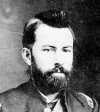 |
|
ologist and ethnologist Edward Palmer (1829-1911).
Born in England, he "emigrated to the United States [in 1849]
at the age of eighteen. He developed an interest in natural history
collecting under the tutelage of Dr. Jared Kirtland and got his first
major opportunity to collect when he was appointed to Captain Page's
Water Witch expedition to Paraguay as hospital steward and botanical
collector in 1853. After the Paraguay expedition he went to England
to visit his mother, got married on March 29, 1856, and came back
to the US. He studied medicine for a few months in Cleveland; |
then
he lived in Kansas, Colorado, and for a few months, California, where
he worked on the Geological Survey of California, collecting marine
invertebrates. During the Civil War, he did medical work in army outposts
in the southwest for a while after the war. He managed to make natural
history collections while working for the army. The rest of his life
was mostly taken up with making archaeological, zoological and botanical
collections for a variety of patrons, primarily in the southwestern
US and Mexico. He is best known for his botanical collections, which
are said to number over 100,000 specimens. He made numerous botanical
collecting trips to Mexico from 1878 to 1910. Rogers McVaugh describes
Palmer's botanical specimens as "exceptionally well documented
for his time," a trait which was obscured by the fact that his
field notes were not distributed with his plants." (From a website
of the Library
of the Gray Herbarium). Palmer was not a professional botanist
or biologist. He made a living wandering throughout the western states
and Mexico, collecting plant and animal specimens of all kinds that
he sold to museums in the United States and England. He also collected
specimens in Florida and Baja. Other better known naturalists like
Spencer Baird, George Engelmann, John Torrey, and Charles Parry often
hired him to collect for them. Funded by the Peabody Museum
at Harvard in 1880, he investigated and retrieved objects from burial
caves known to be in the region of Coahuila, Mexico. In 1890 while
exploring the southernmost coast of Sonora, he was afflicted by spells
of "intermittent fever" (which he probably contracted on
the coast, for the coastal swamps supported hordes of blood-sucking
insects), but he still managed to add 124 specimens to his collection. He was the first to call attention
to the boll weevil that ultimately caused $5 billion in damage to
the American South's cotton crops 50 years later. He worked for the
Department of Agriculture, the Smithsonian Institute and the Army
Medical Museum. It has been stated repeatedly that in 1891 he collected plants on and even led an expedition exploring the flora and
fauna of California and Death Valley. This expedition in fact was organized and initially led by Dr. C. Hart Merriam and sent out by the U. S. Department of Agriculture under the subsequent leadership of Theodore Sherman Palmer (no apparent relationship) to make a biological survey of the region of Death Valley, California, an expedition on which Frederick Vernon Coville, first curator of the US National Herbarium, was the botanist. Undoubtedly there was confusion regarding the name Palmer because it appears that Edward Palmer was in Mexico in 1891.
He suffered personal and professional tragedies such as the death
of his young bride from yellow fever, and the losses of several of
his collections. After his death his field notes sat neglected
on a shelf for more than fifty years. He did however have two
hundred species named for him, and Professor Asa Gray named a genus, Palmerella, in his honor. The genus Malperia was apparently
also named for him, according to Umberto Quattrocchi. He was perhaps
one of the most productive amateur botanists ever to collect a plant. (All taxa except the one listed below)
-
palm'eri: named for Ernest Jesse Palmer (1875-1962), plant collector, botanical taxonomist and naturalist. He was
 |
|
born in Leicester, England, and moved with his parents to the United States in 1878, where they first lived in Warrensburg, Missouri, and then [in 1891] moved to Webb City, Missouri. A bio by Nancy Wallace Brewer on the Find-a-Grave website says: “Although self-educated in the fields of botany, geology, and archaeology, Mr. Palmer acquired a wide reputation in the natural sciences. In 1913 he was appointed to the staff of the Missouri Botanical Garden in St. Louis, and in 1921 he became a research taxonomic botanist with the Arnold Arboretum of Harvard University. Mr. |
Palmer devoted a great deal of his life to studying the flora of his native Missouri. Although specializing primarily in the woody plants, he became a recognized authority of all the state's flora. The Palmer Hawthorn ( Crataegus palmeri), a species native to southwestern Missouri, was discovered by Palmer and bears his name. As a member of the George Washington Carver Memorial Committee he marked the nature trail, identifying the flora, and prepared a collection and explanatory booklet for the George Washington Carver Museum at Diamond, Missouri. Mr. Palmer's extensive collection of geological, archaeological and botanical specimens and artifacts is highly valued and includes a number of rare fossils of Missouri now on display at the Smithsonian Institute in Washington, D. C. An unusually fine herbarium containing 20,000 specimens and a large portion of his various collections were willed to the University of Missouri. Through the generosity of Mr. Palmer his letters and papers covering a thirty year period are deposited in the State Historical Society collections. Mr. Palmer published many scientific pamphlets and treatises, and collaborated with other scientists in writing several books. He also published a volume of poetry, Gathering Leaves, Green, Gold, and Sere in 1958. He was a fellow of the American Association for Advancement of Science, a member of the American Society of Plant Taxonomists, the Botanical Society of America, the American Fern Society, the St. Louis Academy of Science, the New England Botanical Club, the Boston Mineral Club, the Missouri Archaeological Society, and the State Historical Society of Missouri.” He had been interested in the natural world from a young age, and the town of Webb City, Missouri, was a lead and zinc mining boom town when the Palmer family moved there. Palmer concentrated his natural history interest on the Carboniferous age marine fossils which were abundant in the mine tailing piles. In 1913 he began collecting professionally for the Missouri Botanical Garden. Charles Sprague Sargent, founding director of the Arnold Arboretum, was the person mainly responsible for directing Palmer’s career to botany. Palmer and Sargent first became aware of each other through the botanist Benjamin Franklin Bush. Bush had started collecting plants for Sargent and the Arnold Arboretum around 1899, after several years of doing the same for the Missouri Botanical Garden. Sargent offered him a formal post at the Arnold Arboretum in 1921 and he moved to Boston. During his career he collected in almost every state of the United States. He was married at the age of 55 to bacteriologist Elizabeth McDougall Palmer and had three children. He retired in 1948 and returned with his wife and their family to Webb City, Missouri where he died. (Photo credit: "Ernest Jesse Palmer and Charles Sprague Sargent: A Serendipitous Relationship" by Theodore Palmer, Arnoldia 75/2, 2017) ( Eleocharis palmeri)
-
palm'ifrons: with leaves that look like palm fronds.
-
paludico'la: dwelling in marshes.
-
paludo'sa/paludo'sus: marsh-loving.
-
palus'tre/palus'tris:
growing in marshes. from Latin palus, "marsh."
-
pammel'ii: named for Louis Hermann Pammel (1862-1931), botanist and conservationist. The JSTOR entry about
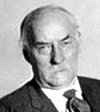 |
|
him relates that: “Louis Pammel was interested in the flora and parks of the upper Mississippi valley. Born at LaCrosse, he graduated from the University of Wisconsin with a BSc in agriculture in 1885. [He also received an MS degree in agriculture in 1889 from the University of Wisconsin]. At this time an interest in medicine led him to began a degree at the Hahnemann Medical College in Philadelphia, but he soon moved to Cambridge, Massachusetts to work as private secretary to the cryptogamic botanist W.G. Farlow of Harvard University. In 1886 Pammel moved again to |
Washington University where he worked for several years as assistant botanist in the Shaw School of Botany and was later awarded a PhD by this university (1899). Finally he settled at Iowa State College in 1889 where he worked as a professor of botany and a researcher at the Iowa Agriculture Experiment Station for over 40 years. His work spanned the fields of taxonomic botany, pathology and floristics, although he was particularly interested in bacterial and fungal infections of plants, weed species and pollination. Pammel's most important works include his Weed Flora of Iowa (1901), a Manual of Poisonous Plants (1910) and the Grasses of Iowa (1914). A keen conservationist Pammel enjoyed outdoor recreation and was a prominent figure in the preservation of Iowa's natural parks. He served as president of the Iowa Park and Forestry Association (1905-1907) and of the Iowa State Board of Conservation (1918-1927), writing the Iowa Conservation Bill. Pammel is in part responsible for the designation of 36 state parks in Iowa and the ‘Pammel State Park’ in Madison now bears testament to his dedication. Also an enthusiastic promoter of environmental education, he passed away while travelling to California where he and his wife of 43 years, Augusta Emmel, would spend the winter months. Leaving behind him five daughters and a son, his botanical legacy includes a herbarium of over 180,000 specimens which is housed in the herbarium of Iowa State College (ISC).” His career at Iowa State spanned 40 years, and the UNC Herbarium gives the following additional information: “In addition to teaching botany, he taught courses in Landscape Architecture (1889-1890). During Pammel's tenure, Iowa State became the first school in the United States to offer bacteriology courses to general students. Pammel was also well liked and respected by his students, many of which considered him a great influence in their lives. Among these students was George Washington Carver. In 1891, Carver became the first African American to enroll at Iowa State College of Agriculture and Mechanic Arts (Iowa State University). Pammel encouraged him to stay at Iowa State as a graduate student after he completed his bachelor's degree (1894). Over the next two years, as assistant botanist for the College Experiment Station, Carver quickly developed scientific skills in plant pathology and mycology, the branch of botany that deals with fungi. He published several articles on his work and gained national respect. Carver completed his master's degree (1896) and was invited by Booker T. Washington to join the faculty of Alabama's Tuskegee Institute. Pammel and Carver remained in close contact after Carver moved to Alabama. In systematic botany, [Pammel] was interested in the trees and other flora of the country, and he made extensive collections of plants, which he gave to the college. For the United States Forest Service, he made a study of grazing conditions in the Uintah Mountains, and did work on grasses of plains region for the U. S. Department of Agriculture. Many honors were conferred upon Dr. Pammel. [He] was a member of numerous professional and honor societies, including the Botanical Society of America, the Ecological Society of America, the American Society of Bacteriology, the St. Louis Academy of Science, the Biological Society of Washington and the Sierra Club. He was twice elected president of the Iowa Academy of Science; was vice president of Section G. Botany, of the American Association for the Advancement of Science (AAAS), and fellow of the AAAS. Pammel was a member of international societies such as Deutsche Bot. Gesellschaft, and the British Ecological Society.” (Photo credit: UNC Herbarium)
-
panaminten'se/panaminten'sis:
of the Panamint Mountains.
-
Pancra'tium: from pankration, an old Greek name for some bulbous
plant, from pan, "all," and kratus, "strong,
mighty," in reference to its supposed medicinal properties. The genus Pancratium was published by Carl Linnaeus in 1753.
-
pandurifor'me: from the Latin pandura, a three-stringed musical
instrument supposedly invented by Pan, and forme, indicating
shape or resemblance, thus "fiddle-shaped."
-
panicula'ta/panicula'tum/panicula'tus:
the species epithet paniculatum refers to the arrangement of flowers in terminal panicles, derives from Latin panicula, "tuft, swelling," and - atus, "having."
-
Pan'icum: from the classical Latin name panus that was used for foxtail millet ( Setaria italica or Panicum italicum), meaning "an ear of millet," also according to Jaeger's Source-Book of Biological Names and Terms a word meaning a swelling, of uncertain application. An additional although not unrelated derivation is that the name Panicum comes from the Latin panis, meaning "bread," perhaps because bread was made from millet, and perhaps the use of the term meaning "swelling" has to do with bread rising as it bakes. The genus Panicum was published by Carl Linnaeus in 1753.
-
pannon'ica: of the Roman province Pannonia, an area which covers
parts of present-day Austria, Hungary and Yugoslavia.
-
panno'sa: felt-like.
-
pan'sa: from the Latin pansus, "expanded, stretched open."
-
papastil'lii: named for Dr. Steven Michael Still (1944- ), the father of Shannon M. Still who published the name.
-
Papa'ver: the classical Latin name for the
poppy. One source says that Plinus, in ancient Greece, claimed that papaver derived from papa = pap, the mashed up food of babies, poppy juice being added to it to help the infants to sleep. The genus Papaver was published in 1753 by Carl Linnaeus.
-
papilla'ta/papilla'tus: same meaning as the next entry.
-
papillo'sa/papillo'sus: having papillae, i.e.
soft protuberances on a surface.
-
pappo'sa: from the Latin for "with pappus."
-
pappus: can refer to the pappus of an asteraceous plant as in Hymenopappus, "membranous pappus," or derived from the Greek pappos, "a grandfather, or the first down on the chin," so down or fuzz.
-
papy'rus: the pith of this plant was used to make rolls of paper
in ancient Egypt and the Greek name was papyros.
-
para-: Greek prefix meaning "beside, alongside, close by."
-
paradi'sa/paradi'sum: from the Latin paradisus which is derived
from the Greek paradeisos, "a park or paradise."
-
paradox'a: unusual, paradoxical.
-
paradoxiclar'a: from Latin paradoxus, "contrary to expectation," and clarus, 'bright, famous.' The authors state that:
"Clarus is to honor Dr. Robert (Germanic for fame + bright) "Bob" Patterson, a faculty member at San Francisco State University with a long interest in student training and in the systematics of Polemoniaceae. His selfless help has contributed
meaningfully to the first author's [Leigh Johnson] research through the years. Paradoxus refers to the unexpected geneticsimilarity of this taxon to Navarretia paradoxinota, and unexpected degree of molecular divergence from N. intertexta."
-
paradoxino'ta: the authors, Leigh Johnson and David Gowen, state: "This specific epithet is derived from the Latin paradoxus, ‘contrary to expectation,’ and nota, ‘mark.’ Nota is to honor Dr. J. Mark Porter, a faculty member at the Claremont Graduate University, researcher at Rancho Santa Ana Botanic Garden, and friend with a career long interest in Polemoniaceae that has contributed substantially to our present understanding of relationships in this family."
-
parali'num: from the Greek paralos, "maritime,"
sometimes used with the sense of "blue like the sea."
-
Para'pholis: from the Greek para,
"near, beside, near to," and the genus Pholiurus,
which derives from pholis or pholidos, "scale,
horny scale," thus apparentlly meaning a nearly related genus to genus Pholiurus. Gledhill says it means irregular scales, and another source says "alternatively, from the Greek para, "beside," and pholis, "scale," alluding to the resemblance of the glumes to the scales of a snake. This seems an unlikely derivation, and what is more likely is that it alludes to the collateral glumes. The genus Parapholis was published by Charles Edward Hubbard in 1946.
- Paraserian'thes: the derivation of the name Paraserianthes is from the Greek para, "close or near to," and the Malaysian tree genus Serianthes. The genus Paraserianthes was published in 1984 by Ivan Christian Nielsen.
-
pardali'num: related to leopards, spotted like a leopard, from the Latin pardus for "leopard." The 7th century scholar Isidore of Seville wrote that "The pard, a beast of many colors, is very swift, likes blood, and kills with a leap. The adulterous mating of the pard with a lion ( leo) produces degenerate offspring, the leopard." It's not clear what animal the ancients were referring to when they used the word 'pard,' but it was probably a leopard.
-
pardal'is: from Latin pardus, "leopard," and -alis, "relating to."
-
Parentucel'lia: named for Tomaso Parentucelli (1397-1455), born to a
poor physician in the Italian region of Liguria,
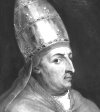 |
|
early Renaissance
librarian to Cosimo de' Medici in Florence, teacher, diplomat and
clergyman who rose first to the Bishopric and then became Pope Nicholas
V, restorer of Rome's city fortifications, churches and aqueducts,
called the Humanist Pope, and known best perhaps because of his establishment
of the Vatican Library and gardens. The following is quoted from Wikipedia:
"Pope Nicholas V, born Tomaso Parentucelli, was Pope from March
6, 1447, to his death. He was born at Sarzana, Liguria, where his
father was a physician. His father died while he was young, but in |
Florence, Parentucelli became a tutor in the families of the Strozzi
and Albizzi, where he made the acquaintance of the leading humanist
scholars. He studied at Bologna, gaining a degree in theology in 1422,
whereupon the bishop, Nicholas Albergati, was so much struck with
his capacities that he took him into his service and gave him the
chance to pursue his studies further, by sending him on a tour through
Germany, France and England. He was able to collect books, for which
he had an intellectual's passion, wherever he went. Some of them survive,
with his marginal annotations. He distinguished himself at the Council
of Florence, and in 1444, when his patron died, he was appointed bishop
of Bologna in his place. Civic disorders at Bologna were prolonged,
so Pope Eugene IV (1431–47) soon named him as one of the legates
sent to Frankfurt to negotiate an understanding between the Holy See
and the Holy Roman Empire, with regard to undercutting or at least
containing the reforming decrees of the Council of Basel. His successful
diplomacy gained him the reward, on his return to Rome, of the title
of Cardinal priest of Santa Susanna (December 1446). He was elected
Pope in succession to Eugene IV on 6 March of the following year,
taking the name of Nicholas V in honor of his early benefactor. The eight scant years of his pontificate
were important in the political, scientific and literary history of
the world. Politically, he made the Concordat of Vienna, or Aschaffenburg
(February 17, 1448) with the German King, Frederick III (1440–93),
by which the decrees of the Council of Basel against papal annates
and reservations were abrogated so far as Germany was concerned; and
in the following year he secured a still greater tactical triumph,
when the resignation of the antipope Felix V (1439–49) (7 April)
and his own recognition by the rump of the council of Basel (1431–39),
assembled at Lausanne, put an end to the Western Schism (1378–1417).
The next year, 1450, Nicholas V held a jubilee at Rome; and the offerings
of the numerous pilgrims who thronged to Rome gave him the means of
furthering the cause of culture in Italy, which he had so much at
heart. In March 1452 he crowned Frederick III as Emperor in St. Peter's,
the last occasion of the coronation of an Emperor at Rome. Within
the city of Rome, Nicholas V introduced the fresh spirit of the Renaissance.
His plans were of embellishing the city with new monuments worthy
of the capital of the Christian world. His first care was practical,
to reinforce the city's fortifications, cleaning and even paving some
main streets and restoring the water supply. The end of ancient Rome
is sometimes dated from the destruction of its magnificent array of
aqueducts by 6th century invaders. In the Middle Ages Romans depended
for water on wells and cisterns, and the poor dipped their water from
the yellow Tiber. The Aqua Virgo aqueduct, originally constructed
by Agrippa, was restored by Pope Nicholas V, and emptied into a simple
basin that Leon Battista Alberti designed, the predecessor of the
Trevi Fountain. But the works on which he especially
set his heart were the rebuilding of the Vatican and the Borgo district,
and St Peter's Basilica, where the reborn glories of the papacy were
to be focused. He got as far as pulling down part of the ancient basilica,
and made some alterations to the Lateran Palace (of which some frescos
by Fra Angelico bear witness). Under the generous patronage of Nicholas
V, humanism made rapid strides as well. The new humanist learning
had been looked on with suspicion in Rome, a possible source of schism
and heresy, an unhealthy interest in paganism. Nicholas V instead
employed Lorenzo Valla as a notary and kept hundreds (confirm; this
seems high) of copyists and scholars, with the special aim of wholesale
translations of Greek works, pagan as well as Christian, into Latin,
giving as much as ten thousand gulden for a metrical translation of
Homer. This industry, coming just before the dawn of printing, contributed
enormously to the sudden expansion of the intellectual horizon. Nicholas
V founded a library of nine thousand volumes. The Pope himself was
a man of vast erudition, and his friend Aeneas Silvius Piccolomini,
later Pope Pius II (1458–64), said of him that 'what he does
not know is outside the range of human knowledge. He was compelled, however, to add that
the lustre of his pontificate would be forever dulled by the fall
of Constantinople, which the Turks took in 1453. The Pope bitterly
felt this catastrophe as a double blow to Christendom and to Greek
letters. 'It is a second death,' wrote Aeneas Silvius, 'to Homer and
Plato'. Nicholas V preached a crusade, and endeavoured to reconcile
the mutual animosities of the Italian states, but without much success.
He did not live long enough to see the effect of the Greek scholars
armed with unimagined manuscripts, who began to find their way to
Italy. In undertaking these works Nicholas V was moved 'to strengthen
the weak faith of the populace by the greatness of that which it sees'.
The Roman populace, however, appreciated neither his motives nor their
results, and in 1452 a formidable conspiracy for the overthrow of
the papal government, under the leadership of Stefano Porcaro, was
discovered and crushed. This revelation of disaffection, together
with the fall of Constantinople, darkened the last years of Pope Nicholas
V; "As Thomas of Sarzana," he said, 'I had more happiness
in a day than now in a whole year'." The genus Parentucellia was published by Domenico Viviani in 1824.
-
Parietar'ia: derives from the Latin parietarius,
"of walls," which descends from Greek paries, "a
wall," where the plant likes to grow, as Pliny knew when he described
it. The genus Parietaria was published by Carl Linnaeus in 1753.
-
parikh'iae: named for Dr. Anuja Parikh (1959?- ), Indian-born American botanist who with her husband Dr. Nathan Gale, also a botanist, lives in Santa Barbara. She came to the United States from India in 1983 at the age of 24 to pursue her doctorate studies at the University of California, Santa Barbara, where she first met her husband. They have been surveying and studying plants across Santa Barbara, Ventura, San Luis Obispo, Los Angeles, Kern, and Riverside Counties in California for more than 30 years, and were among the botany team who rediscovered a once-believed to be extinct plant called the San Fernando Valley spineflower in 2000.
-
Parishel'la: see entry below. The genus Parishella was published by Asa Gray in 1882.
-
parish'ii: named for Samuel Bonsall Parish (1838-1928), He and his brother William Fletcher Parish (1840-1918) were
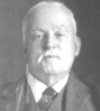 |
|
both botanical collectors who lived on a ranch in San Bernardino, California and made extensive exploring trips through the mountains and deserts. Their father was the Methodist Episcopal Reverend Daniel Parish, and they had at least one half-sister, and they were both Civil War veterans. One website says Samuel (and possibly William also) was born in Paterson/Newark, New Jersey. Samuel was the more devoted of the two and is the one that we have the most information about. He corresponded with and was on very familiar terms with many of the leading botanists |
of his day. He went to Wesleyan University 1854-1856 and New York University 1856-1858 graduating with a BA, and was a high school teacher from 1858 to 1860 at Ottawa Academy in Ottawa, Illinois, and then for a time at Barton Academy at Mobile, Alabama. He served as 1st sergeant with Company K of the 2nd Kansas Voluunteer Cavalry. After the War, both brothers moved west and were thinking about getting into mining which was becoming a big thing. They ended up buying a ranch in San Bernardino around 1872. They occupied themselves with growing fruit while at the same time exploring the region and collecting plants in the San Bernardino and San Jacinto Mts, and in the Mojave Desert. They were in contact with major botanists of the time such as Sereno Watson and Asa Gray, who with his wife visited the Parishs at their ranch in 1885. They were joined by C.C. Parry on a number of collecting trips. Others who visited them included Edward Palmer, E.L. Greene, Cyrus Guernsey Pringle, John Gill Lemmon, Charles Sprague Sargent, Michael Schuck Bebb, Harvey Monroe Hall, Willis Lynn Jepson, and George Engelmann who joined Parry and Samuel Parish on a visit to Whitewater Canyon where he, Engelmann, saw his first Opuntia bigelovii, and being very excited, backed into another cactus, upon which Parish proclaimed “I spent the afternoon prying Engelmann loose." William Parish had moved to Hermosa Beach/ Redondo but passed away in 1918 at the Wadsworth VA Soldier’s Home. Samuel’s last collecting trip was 1920, after which he and Eliza moved to Berkeley for better access to herbaria, and later was appointed Honorary curator of the University of California Herbarium and became a lecturer and professor at Stanford. In his late 80’s Samuel was working on his Flora of the Mojave Desert, but unfortunately his house, unpublished manuscript and papers were lost in the Berkeley fire of 1923. He had sold his personal herbarium to Stanford University in 1917 and when he moved north he sold his large library to Pomona College and it is now at Rancho Santa Ana Botanic Garden. Samuel passed away at the age of 91 in 1928. He was the author of "Trees of Southern California," "A Catalog of Plants Collected in the Salton Sink," "Little or Little-Known Plants of Southern California," "A Catalog of Plants Collected in the Salton Sink," "A Contribution Toward a Knowledge of the Genus Washingtonia," "The Immigrant Plants of Southern California," and "A Group of Western American Solanums." About William Parish, David Hollombe provides the following: "William served in the Civil War as a sergeant and later Sergeant-Major in company C, 15th New Jersey Volunteer Infantry. The Daniel Parish family is listed in the 1840 census at Westfield, Richmond County, NY. William is alone at Morris Township, Morris County, NJ, in 1860 and at Branch twp., Stanislaus County, CA, in 1870. He is registered at San Bernardino up to 1890, and at Long Beach in 1892. He was in Chester, PA, in 1898 and 1900, staying with Dr. Daniel Parish Maddux (his half-sister's son, who served on the local Board of U. S. Pension Examiners). By 1906 he was living at Redondo, and later in Hermosa Beach." Of all the taxa with the name parishii, the majority were collected by S.B. Parish and the rest are listed with both brothers as co-collectors. Therefore it would seem as though most taxa are named for the elder brother.
-
park'eri: named for Joseph Chamberland Parker (1834-1910). Thanks to
David Hollombe for providing the following information: "He was
a photographer, not a painter. He was born in Cincinnati but his family
moved to Peoria in 1836. He became a professional photographer in
1857, moving to Pekin, Illinois in 1862 and coming to California in
1872. In 1873 he settled at San Diego and remained there through 1892.
His son, Wallace Brown Parker, joined him in his business, and Wallace
is listed in Los Angeles city directories from 1892 to 1899. The 1900
census shows them in Tucson, and they moved to Los Angeles just 8
months before Joseph's death. Parker, along with lawyer George N.
Hitchcock, also collected the type specimen of Agave shawii,
following Parry's notes from the boundary survey, sending the specimens,
along with photographs, to [George] Engelmann. Engelmann had named
the cactus for Parker, but did not publish the name. 12 years after
Engelmann's death, J.M. Coulter published it but, not being familiar
with J.C. Parker, indicated that it had been collected by C.F. Parker.
The other Parker (Charles) was a bookbinder in Camden, NJ, who made
himself useful at the Academy of Natural Sciences of Philadelphia
and was elected a member in 1865, a curator in 1874 and eventually
"curator-in-charge" of the Academy. He was one of the founders
of the conchological and botanical sections and was also interested
in entomology." What is now called Cylndropuntia bernardina has many synonyms of which Cylindropuntia californica var. parkeri is one. J.C. Parker's brother Francis W. Parker was also a professional photographer. J.C. Parker at one time or another had studios in Illinois, Los Angeles, San Diego and San Francisco.
-
Parkinson'ia: named for John Parkinson (1567-1650), Apothecary of London and king's herbalist to James I,
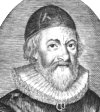 |
|
Parkinson was a leading figure in the European botanical renaissance and Thomas Johnson is said to have gathered seeds at his famous garden in Long Acre, London. He was also a founding member of the Worshipful Society of Apothecaries in December 1617, and was later Royal Botanist to Charles I. He was born and spent the early part of his life in Yorkshire and moved to London at the age of 14 to apprentice as an apothecary. He assisted the Society of Apothecaries in preparing a list of all the medicines that an apothecary should stock. His work Paradisi in Sole |
Paradisus Terrestris (1629) generally described the proper cultivation of plants and has been described as the earliest important treatise on horticulture published in England. His other major work published in 1640 was Theatrum Botanicum (The Botanical Theatre or Theatre of Plants) which was according to many the most complete and beautifully presented English treatise on plants of its time. Parkinson maintained contacts with sources at home and abroad such as John Gerard, John Tradescant the elder, and Matthias de L’Obel, actively sought new varieties of plants, financed plant-hunting expeditions abroad, and introduced new species. He was a pious Catholic and yet was forced to maintain a quiet faith in the face of the Catholic-Protestant troubles, and in the end his family was torn asunder by the English Civil War (1642-1651). His botanical garden about which little is known except that it was about two acres and contained about 480 species was in Covent Garden. He died in London and was honored with the genus Parkinsonia, published in 1764 by Carl Linnaeus.
-
parksia'na: named for mycologist and botanist Harold Ernest Parks (1880-1967) and his wife conservationist Susan
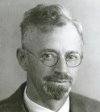 |
|
Priscilla Thew Parks (1878-1968). Harold Parks was born in Albany, Oregon, and moved to the San Francisco area in 1890 after his father’s death. A JSTOR website says: “Joining the California National Guard, he served in 1898 during the capture of Guam and Manila. After being injured and discharged in 1899, he spent a decade as a salesman in Tacoma before moving back to California with a wife and three children. Here Parks continued in various employments while studying languages and botany, and developed a special interest in hypogeous fungi. He collected plants and fungi around San Jose from 1916-1921, striking up a correspondence with the botanists W.A. Setchell and W.A. Murrill. His first papers on Californian fungi appeared in 1919 and in 1921, in which year he was offered a technician position at Berkeley by Setchell, and then from 1922-1928 was employed as a botanical collector for the University. He then continued to work for the botany department at Berkeley as a volunteer associate herbarium curator, until 1950, thereafter holding the title of honorary curator until his death. As well as collecting local material for classes, Parks |
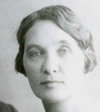 |
served on expeditions to Tahiti (1922), the Tonga Islands (1926, with J.M. Ostergard) and Fiji. He often collected on behalf of other botanists and mycologists, as well as for the university. Parks divorced his first wife in 1924 and married Susan Threw in 1927. Together they collected plants in Raratonga and the other Cook Islands in 1930. From 1931 they lived on the Pacific coast at Trinidad, Humboldt County, where Parks continued his mycological work for another 20 years, often collaborating with Joseph Tracy. His herbarium of California fungi eventually reached some 9,000 numbers, almost all deposited at the University of California Herbarium. Various plant taxa were named in his honor, such as the fungus Parksia libocedri, Asplenium parksii and Maesa parksii.” The National Park Service has this to say about his wife: “Susan had originally come to California to escape the harsh Ohio winters with her father, Richard Thew, a wealthy industrialist and inventor. In the summer of 1918, having determined to stay year-round, she drove the rough dirt road to Giant Forest and encountered the beauty and serenity of the sequoias for the first time. Although she only spent a limited amount of time within the park, she was instantly captivated. She soon acquainted herself with the superintendent of the park, Colonel John R. White, and learned of the various efforts to create a greater Sequoia National Park. It was then that the idea of promoting for park expansion began to take hold of Susan Thew and she began her travels into the high country east of Sequoia - the High Sierra. For the next several years, with determination and ambition, Susan applied herself to the campaign to preserve the grand wilderness of the Southern Sierra. She spent several summers traversing some of the most rugged terrain in the continental United States. With one companion and small packtrain, she covered hundreds of miles, photographing the landscape in hopes of conveying something of its beauty. With these images, the largest and most complete photographic record of the region to date, Thew produced a publication for distribution to members of Congress promoting the park idea entitled The Proposed Roosevelt-Sequoia National Park. Little did Thew know that her work would succeed in nearly tripling the park's acreage - making her one of the most prominent female figures in the history of these parks.”
(Photo credit: National Park Service)
-
Parnas'sia: named for Mt. Parnassus of Greece, of uncertain application, except that Linnaeus liked to use names from Greek and Roman history and mythology.
The genus Parnassia was published by Carl Linnaeus in 1753.
-
Parony'chia: from the Greek paronychia, "a whitlow,"
which is a painful infection of the finger, especially beneath the
nail, derived in turn from para, "near," and onyx,
"nail." One of the common names for Paronychia is
whitlow-wort, an herb thought to be a cure for whitlow. The genus Paronychia was published by Philip Miller in 1754.
-
Paro'sela: an anagram of the name Psoralea. The genus Parosela was published by Antonio José Cavanilles in 1802.
-
par'qui: ???
-
Parr'ya: named for Rear Admiral Sir William Edward Parry (1790-1855). He was born in Bath, Somerset, the son of
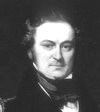 |
|
Dr. Caleb Hillier Parry, was educated at King Edward's School, and at the age of 13 joined the Royal Navy as a First-class Volunteer. He was quickly promoted to Master’s Mate, Midshipman and Lieutenant. After seeing action against the Danish flotilla, he spent much time making astronomical observations and charting portions of coastlines of Sweden, Norway and the Shetland Islands. In 1813 he was assigned to the North American station and saw action in that theater against American privateers. At this time the British were very interested in trying to determine if |
there was a northwest passage, and Lieutenant Parry in 1818 was given command of one of the expedition ships under the overall command of Captain (later Sir John) Ross. This expedition was a failure but the next year a second expedition was outfitted under the command of Lieutenant Parry. This expedition reached points never reached before but ultimately was unsuccessful, although they wintered over frozen in the ice at Melville Island in the Arctic from 1819 to 1820, and endured months of darkness and brutal cold. He was scrupulous in his care of the crew, all of whom survived, and returned home with a mass of scientific data to great popular enthusiasm which was stoked by the publication of Journal of a Voyage to discover a North-west Passage. In 1821 and 1824 he participated in two more expeditions to the Arctic. His fifth Arctic expedition in 1827 over the ice from Spitsbergen in an attempt to reach the North Pole was ultimately unsuccessful but his “Farthest North” stood for nearly 50 years. He was knighted in 1829, was Commissioner of the Australian Agricultural Company, 1829-1834, assistant poor-law commissioner in Norfolk, 1835-1836, controller of the steam department of the Navy, 1837-1846, and captain-superintendent of Haslar Hospital, 1846-1852. He was promoted to Rear Admiral in 1852 and was lieutenant governor of Greenwich Hospital in 1853. One of his publications was Chloris Melvilliana. A list of plants collected in Melville Island. Parry pioneered the use of canning techniques for food preservation on his Arctic voyages. However, his techniques were not infallible: in 1939 viable spores of certain heat-resistant bacteria were found in canned roast veal that had travelled with Parry to the Arctic Circle in 1824. He died in the Rhineland Palatinare of Germany but was buried in Greenwich. The genus Parrya was published by Robert Brown in 1823.
-
par'ryae: named for Emily Richmond Preston Parry
(1821-1915), second wife of Dr. Charles Christopher Parry. She was born in Ashford, Connecticut. Her first husband was John A. Preston and her second was C.C. Parry whom she married in 1859. She died in Stafford, Connecticut.
- parrya'na: named for Thomas Gambier Parry (1816-1888), British artist and art collector. He was born in Chelsea,
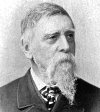 |
|
Middlesex, England. The following is quoted from Wikipedia: “He is best remembered for his development of the Gambier Parry process of fresco painting, and for forming the significant collection of early Italian paintings and objects that his heirs gave to the Courtauld Institute of Art in London, where many are displayed in the Courtauld Gallery. Gambier Parry's parents, Richard and Mary Parry of Banstead, Surrey, died when he was young and he was raised by his maternal aunts and uncles, the Gambiers. He was the nephew of James Gambier, 1st Baron Gambier. He |
was educated at Eton and Trinity College, Cambridge. He moved to Highnam Court, Gloucestershire when he was 21 and, in 1839, he married, firstly, Anna Maria Isabella Fynes-Clinton, daughter of Henry Fynes Clinton. Only two of their six children survived to adulthood, Clinton Charles Parry and Charles Hubert Hastings Parry (the composer); Isabella survived the birth of Hubert in 1848 by only twelve days. In 1851, Gambier Parry remarried, this time to Ethelinda Lear, daughter of Francis Lear, Dean of Salisbury, by whom he had six more children. Gambier Parry devoted his inherited wealth to good works. [He] was a prominent member of the Ecclesiological Society. Thomas Gambier Parry was a notable collector of medieval and Renaissance art; the Courtauld Institute was bequeathed his collection in 1966. After studying the technique of the Italian fresco painters, he developed his own spirit fresco method and executed grand-scale mural projects at Ely Cathedral, Gloucester Cathedral and the parish church at Highnam. He gained the reputation of a philanthropist, founding a children's hospital, orphanage, and college of science and art at Gloucester, and providing a church and school for his tenants at Highnam. He constructed the Church of the Holy Innocents, Highnam between 1849 and 1851 in memory of his first wife and those of his children who had died at early ages. Gambier Parry adorned the whole of the chancel, including the roof, and much of the nave with frescoes using the new Gambier Parry process he adapted from his study of Italian fresco painters. He is buried there in a tomb designed by his son Sidney. He started to lay out the Highnam Court gardens in 1840 and was one of the first to make a pinetum, which is an arboretum of pine trees or other conifers for scientific or ornamental purposes; by 1874 the gardens rivalled any in the UK. He died in Highnam, Gloucestershire, England. (Pinus parryana)
-
par'ryi/par'ryana: named for Dr. Charles Christopher Parry (1823-1890), an English-born American botanist and
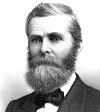 |
|
botanical collector with the Pacific Railway Survey who visited the southwestern mountains and deserts many times and is remembered in the names of more than a score of California native plants. During his long career, he became the trusted colleague of many major naturalists such as John Torrey, Asa Gray, George Engelmann, John Muir, Charles Wright, Edward Green, Edward Palmer, John G. Lemmon, and Sir Joseph Hooker, son of William Hooker and like his father the director of Kew Gardens in London. He was a member of both the Mexican Boundary Survey |
and the Pacific Railway Survey, but he was better at discovering new species than at describing them. One of his most beautiful finds was Lilium parryi, the lemon lily. Few American botanists have covered as much and as many different areas as he did. He was born in Gloucestershire but moved to the US in 1832 where his family settled first in northeastern New York. It was here and in the following years that he began collecting specimens of plants. He had two brothers and six sisters. He was educated in good schools and finally studied medicine at Columbia University where he studied with John Torrey and got his medical degree. Larry Blakely in his excellent Who’s in a Name essay says: “He became life-long friends with both Torrey and Torrey’s protégé Asa Gray, as well as with their St. Louis associate George Engelmann – the 3 pillars of mid-19th century US botany.” Parry moved west in 1846, settling in Davenport, Iowa, and setting up a medical practice. From 1848 to 1855 he was a surgeon and botanist for the United States and Mexican Boundary Survey led by Maj. William Hemsley Emory. In 1853 he married his first wife, Sarah Dalzell, who died after five years leaving him a single daughter. In 1859 he married his second wife, Emily Preston. He made many plant collections in California, Colorado, Utah and other western states. David Hollombe says: “Dr. Parry won world-wide fame and did much to build up the reputation of the Davenport Academy of Sciences as a center of scientific work and research.” He was repeatedly president of this Academy, as well as a fellow of the American Association for the Advancement of Science and a member of numerous other associations. I don't have much information about the period 1855-1869 but I assume he spent that mostly in the field collecting. I know much of his Rocky Mountain work in Colorado was during this time. From 1869 to 1871 he was botanist to the United States Agriculture Department and spent much of that time in Washington. During this period also he made a visit to his home country and established what would be a lasting friendship with Sir Joseph Hooker at Kew, who later referred to him as the King of Colorado botany. In 1872 he accompanied Asa Gray to the summit of the mountain Parry had named for Gray, one of two that had attracted his attention, the other being named by him for John Torrey. He created a private herbarium that was one of the finest in America, comprised of over 18,000 specimens of some 6,800 species. It has been an article of faith until recently that C.C. Parry first described the Torrey pine and named it Pinus torreyana after his friend and colleague, but it appears now that although Parry was the one who originally described this pine, he was not the one who validly published the name, and that was the French botanist and conifer authority Élie-Abel Carrière. Parry’s name however is associated with numerous species and deservedly so. Parry was first and foremost a field botanist, and his careful firsthand observations and scrupulously recorded notes are testament to his stature as one of the giants of American botany. He died at his home in Davenport, a much-loved, widely-known and deeply-respected caretaker and student of the natural world.
-
parsons'iae: named for Mary Elizabeth Parsons (Mrs.John Carpenter Hawver) (1859-1947), author of The Wild
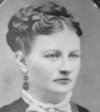 |
|
Flowers of California: their names, haunts and habits (1897). She was born in Chicago and moved to the Bay Area in her formative youth and later studied in San Francisco at the John Hopkins Institute of Art. Her mother was Melissa Dutton Parsons whose younger sister was Adaline Elizabeth Dutton, married to Albert Emmett Kent, also loving in Chicago. The Kents had a son William, the future Congressman from California, and it was in 1871 that they moved to Marin County, California. Mary Elizabeth’s mother passed in 1883 and it was in that year she went to |
stay with her aunt Adaline and her cousin William who was like a brother to her. Through her cousin she came to know a wide circle of friends who shared her interests in natural history including Theodore Roosevelt, John Muir and Alice Eastwood, curator of botany at the California Academy of Sciences. During her studies in the 1890s, Parsons would venture into natural gardens and outside spaces, sketching alongside fellow artists Alice Brown Chittenden and Margaret Warriner Buck. Parsons began a project with Warriner Buck to record and catalog the flowers encountered. This resulted in the 1897 publication of The Wild Flowers of California: Their Names, Haunts, and Habits, which was one of the first field guides to identify and classify the wild flowers of California. Republished multiple times over the past century, this volume represents a collaborative project between Chittenden and naturalists Mary Elizabeth Parsons and Margaret Warriner Buck. Both Parsons and Buck exuded the era's persona of the “new woman.” Parsons, a represented artist in Saint Mary’s College Museum of Art's exhibition Feminizing Permanence, sought to create a guide specific to California flora. She intended the guide as a West Coast version to complement Mrs. William Starr Dana's plant guide, How to Know the Wild Flowers, published in 1893, which mostly dealt with the East Coast. Recognizing a need to identify the West Coast foliage, Parsons observed and recorded field notes on the plants she and Warriner Buck encountered on their hikes and excrsions. Later, Parsons transcribed these notes into precise guide entries, taking into consideration her audience and other similar plants as points of comparison. Ultimately, Parsons determined to organize the book classifying the flowers by color. Indeed, she credits her book's organization to Dana's guide. Despite both women working as artists, the pen-and-ink illustrations (over 100 engraved into plates for the book's publication) were drawn by Warriner Buck and not by Parsons. The original printing plates made from these illustrations for the 1897 publication version were destroyed in the 1906 earthquake. The 1906 edition was printed with new plates following the disaster. In 1910 she met the dentist Dr. John Carpenter Hawver of Auburn, California, who shared her love of natural history and was impressed with her book. He arranged to meet her and they were married two years later. For all his life he had been interested in the natural world and particularly in geology. He had participated in the excavation of many extinct animal fossils, especially in a cave in El Dorado County now known as Hawver Cave. Regrettably, he died from an apparent heart attack only two years after their marriage, and Mary left Auburn and returned to the Kent estate in Marin County, where she lived for the remainder of her life. It was John Muir who gave her the moniker of Miss Wildflower of California. (Photo credit: Find-a-Grave)
-
parsonsia'na: named for Samuel Bowne Parsons, Sr. (1819-1906), noted horticulturist and son of the Quaker Samuel
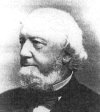 |
|
Parsons and Mary Bowne. The Parsons family were champions of religious freedom. Samuel Parsons was a Quaker minister and farmer. He acquired trees and shrubs with the intention of establishing a nursery to pass on to his sons upon his death. That land became the well-known Parsons Nursery established by his son Samuel. There seems to be some confusion on this matter with some sites indicating it was the father who established the nursery, but others indicate that it was his son Samuel Bowne Parsons. An entry in his journal refers to his having borrowed $5000 |
from a bank, a large sum at the time, to start the business with his brother Robert B. Parsons. At the time Flushing was one of the major horticultural centers in America with numerous flourishing nurseries. Parsons Nursery, located at the site of the present Flushing High School, was a source of many trees and shrubs for American gardens. Parsons introduced the pink-flowering dogwood, and for a time he was the only grower of hardy rhododendrons and azaleas. He traveled to Europe in search of fine specimens for his nursery, and in 1847 brought back an oddity known as the European Weeping Beech in a small flowerpot. Additionally, he introduced the Valencia orange and the first frost resistant honeybee into the US. Some notable specimens still survive at Bowne House, and these plants can be enjoyed by visitors today. One site, the Find-a-Grave entry for him, says he graduated from Haverford College, but I have not been able to confirm that. He married three times, Susan R. Howland in 1842, who died in 1854, Elizabeth Butterworth in 1858, and Clara Weylan in 1862. He had four children with Susan Howland, including Samuel Bowne Parsons, Jr. who became the well-known American landscape architect who is remembered primarily today for his accidental introduction of the fungus that led to the near extinction of the formerly widespread American chestnut tree. Samuel, Sr. and Robert ran the nursery, sending their collectors all over the globe in search of specimens. Their customers included the most important landscape architects of the day, notably Frederick Law Olmsted and Calvert Vaux, who bought trees from the Parsons nursery for use in their designs of Central and Prospect Parks. He was also an active member of the underground railroad whose obituary noted, ''It was his boast that he assisted more slaves to freedom than any other man in Queens County.'' The nursery, as a major business doing a brisk trade all over America, provided a perfect vehicle for enabling the transport of slaves from the south to areas of the north and to Canada. It is said that Parsons moved the slaves to freedom concealed in plant material in his wagons. He carried on a correspondence with John Torrey. He was the author of Parsons on the rose: A treatise on the Propagation, culture, and history of the rose, and The rose: its history, poetry, culture, and classification. Another of his brothers, William B. Parsons, is listed as a horticulturist in an 1850 census. His son, Samuel B. Parsons, Jr., worked in partnership with Calvert Vaux, one of the original designers along with Frederick Olmsted of New York’s Central Park, and served as superintendent of plantings, chief landscape architect, and superintendant of the Parks Department. He was also president of the American Society of Landscape Architects, and landscape architect for the American Society for the Preservation of Scenic and Historical Places and Objects. Present-day Kissena Park was the location of the Parsons Nursery.
-
parthen'ium/Parthen'ium: one source says this epithet comes from the classical Greek name parthenion for a plant now known as Tanacetum parthenium, but a Missouri Botanical Garden website says that "The genus name Parthenium comes from the Greek word parthenos meaning 'virgin,' in reference to the fertile ray florets and infertile disk florets of species in this genus." This well illustrates the fact that the derivation of a species name may well be different from that of a generic name. but the two derivations here are not necessarily in disagreement.
-
Parthenocis'sus: from the Greek parthenos, "a virgin,"
and kissos, "ivy," a genus whose common name is woodbine
or virginia creeper, Virginia having been named for England's virgin
queen Elizabeth I. The genus Parthenocissus was published by Jules Émile Planchon in 1887.
-
par'va/par'vum: small.
-
parvicapita'tum: small-headed.
-
parviflor'a/parviflor'um/parviflor'us:
from the Greek parvus, "small," and flora,
"flower," hence "small-flowered."
-
parvifo'lia/parvifo'lium:
small-leaved.
-
parvilo'ba: small-lobed.
-
Parvise'dum: from the Latin for "small Sedum." The genus Parvisedum was published by Robert Theodore Clausen in 1846.
-
par'vula/par'vulum/par'vulus: somewhat small.
-
par'vum: small.
-
Pascopy'rum: an unusual combination of Latin pasco, "to
feed, pasture" and Greek pyros, "grain, wheat."
The genus Pascopyrum was published by Áskell Löve in 1980.
-
Pas'palum: from the Greek paspalos for "millet." The genus Paspalum was published Carl Linnaeus by in 1759.
-
Passiflor'a: from the Latin passio,
"passion," and flos, "flower." The name
was given because the plant parts seemed to represent aspects of Christ:
the corona was the crown of thorns, the five stamens were the five
wounds, the three styles three nails, and the ten petal-like parts
the ten faithful apostles. The genus Passiflora was published by Carl Linnaeus in 1753.
-
Pastina'ca: one source says from the Latin pastino, "to prepare the ground for planting," while another says from
the Latin pastus, "food." This was the ancient name
of the parsnip and may give a clue as to the origin of the Italian
word pasta. The genus Pastinaca was published by Carl Linnaeus in 1753.
-
patagon'ica/patagon'icum: of or from Patagonia,
a region in Chile and Argentina.
-
pat'ens:
spreading, from Latin patina, "pan or broad, shallow dish," from the Greek patane, "plate, dish," in turn from the Proto-Indo-European root pete-, "to spread."
-
patellar'is: dish- or saucer-shaped.
-
patellif'era: presumably bearing some structure or other that is
dish-shaped.
-
paterson'ii: named for William Paterson (1755-1810), Scottish soldier, explorer, lieutenant governor and botanist
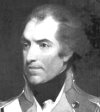 |
|
best known for leading early settlement at Port Dalrymple in Tasmania. An entry on his Find-a-Grave website says: “He trained as a biologist in his youth and in 1777 he was sent to the Cape Colony, South Africa, by the Countess of Strathmore to collect plants. In 1780 he returned to England and joined the British Army the following year, originally serving as an ensign with the 98th Regiment of Foot in India. In 1789 he was promoted to the rank of Captain in the New South Wales Corps. From November 1791 until March 1793 he was commander of Norfolk Island |
between Australia and New Zealand, where he collected plant and insect specimens for British scientist Sir Joseph Banks. From 1794 until 1795 he served as lieutenant governor of New South Wales, Australia. In 1801 he led several expeditions in New South Wales and three years later he led another expedition to Tasmania, where he was appointed the 1st commandant at the newly established Port Dalrymple, serving in that position until March 1808. In January 1809 he was appointed temporary acting governor of New South Wales, replacing the famous William Bligh. After being replaced by Colonel Lachlan Macquarie later that year, he left for England but died enroute aboard the HMS Dromedary at the age of 54. In 1798 he was elected a fellow of the British Royal Society for his contributions to botany.”
-
pattersonen'sis: the -ensis suffix is usually used to indicate
a geographical location, and thanks to David Hollombe, we have the
following: "Vol. 4 of LeRoy Abrams' Illustrated Flora of the Pacific
States gives the type locality of Senecio pattersonensis as Mount Patterson, Mono county. Mt. Patterson is in the Sweetwater
Mountains, north of Bridgeport."
-
patterson'ii: named for Harry Norton Patterson (1853-1919). The following
is quoted from Al Schneider's excellent website on Southwest
Colorado wildflowers: "Illinois newspaper publisher and amateur botanist who visited Colorado often. He took over the Oquawka Spectator which he and his wife Florence published after his father, Edward (or Edwin) H. N. Patterson moved to Denver in 1875. (Patterson, the elder, and Eugene Field were associates of Edgar Allen Poe and had attempted to have Poe move to Oquawka. Patterson also corresponded with Poe about financing Poe's longed-for literary magazine, the "Stylus", but Poe died of alcohol poisoning before the two could work out the publishing details). H.N. Patterson was a correspondent with prominent American botanists of the time and he printed botanical labels for many collectors. His botanical collections are housed in a number of herbaria around the United States. In 1874 Patterson wrote "A List of plants collected in the vicinity of Oquawka, Henderson County, Ills." Of this list Patterson said, "709 species are enumerated (not including mosses), and of these I have found 654 within three miles of Oquawka." In 1892 Patterson published "Patterson's Numbered Check-list of North American Plants North of Mexico." (Draba pattersonii, Poa pattersonii)
-
patterson'ii: named for botanist and biologist Robert William Patterson (1947- ). He received a BA in botany in 1969 from UC Santa Barbara and a PhD in biology from the same school in 1975. He has been a professor in botany and biology at San Francisco State University since 1979, and teaches the folllowing courses: Plant Taxonomy, Plant Anatomy, Plant Evolution and Diversity, Introductory Biology, Flora of the Northern Sierra Nevada and Plants and Human Affairs. (Linanthus dichotomus ssp. pattersonii, Navarretia paradoxiclara) Of the latter epithet, David Hollombe has a note on his list that "Clarus is to honor Dr. Robert Patterson and is Germanic for fame and 'bright.' "
-
pattonia'na: named for George Patton (1803-1869). The Dictionary of National Biography entry about him relates that
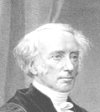 |
|
he was a “Scottish judge, third son of James Patton of the Cairnies, sheriff-clerk of Perthshire, was born at the Cairnies in 1803. He received the rudiments of his education at Perth, and proceeded thence to Oxford, where he does not seem to have matriculated. Returning to Scotland, he began his legal studies at Edinburgh University, and was admitted advocate in 1828. He made some figure at the bar as a pleader. But he was an ardent tory in politics, and it was not until Lord Derby's second government came into power in 1859 that Patton, after very many delays and |
disappointments, received official recognition. He then became solicitor-general for Scotland for a few weeks. In the spring of 1866 he entered the House of Commons as conservative member for Bridgewater, and a few weeks later, when Lord Derby's third administration was formed, he was made lord advocate. The appointment necessitated a new election at Bridgewater, and Patton was defeated by Mr. Vanderbyl. Reports were abroad that gross bribery had been practiced at both these elections, and a commission was appointed to inquire into these charges. The dread of compromising disclosures preyed on Patton's mind, but he was relieved of the necessity of taking any part in the inquiry by becoming, in 1867, lord justice clerk. John Inglis had resigned the post to take that of lord president. The choice of his successor lay with the lord advocate, and Patton conferred the office on himself. He assumed the title of Lord Glenalmond. In August 1869 he succeeded to the estate and mansion at Glenalmond on the death of his elder brother, Thomas Patton, W.S. By some journalistic blunder the death of Thomas had been announced as the ‘demise of the lord justice clerk,’ and the error prejudicially affected Lord Glenalmond's mind. On Thursday, 16 Sept. 1869, he presided at the Ayr circuit, and on the following day he returned with Mrs. Patton to Edinburgh, proceeding thence to Glenalmond. On the morning of Monday, 20 Sept., he committed suicide. The body was interred in the family burying-ground of Monzie. He left a widow, but no family. Though possessed of considerable legal talents, he had no favourable opportunity for displaying administrative ability. In the management of his own small estate of the Cairnies he made many valuable experiments in arboriculture, and had projected elaborate trials of various conifers at Glenalmond.” He was interested in the cultivation of exotic trees, particularly conifers, and was one of the organizers and chairman of the Oregon Botanical Association and its fund that enabled John Jeffrey to explore the forests of northwestern America. Jeffrey discovered Abies pattoniana, aka Patton’s hemlock or Patton’s spruce, on the Mt. Baker Range. There is no relation between this George Patton and the American General. (Photo credit: National Galleries of Scotland)
-
pat'ula/pat'ulum: somewhat spreading.
-
pauci-: few, from Latin paucus, "few."
-
paucidenta'ta: from the Latin meaning "few-toothed."
-
pauciflor'a/pauciflor'um/pauciflor'us:
few-flowered.
-
paucifo'lia: with little foliage, literally "few-leaved."
-
pauciradia'ta: from the Latin for "few-rayed"
(Compare pleniradiata).
-
paul'ii: named for William Paul (1822-1905), English rosarian, horticulturist and writer, best known for his book
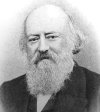 |
|
The Rose Garden. Wikipedia says: “Born at Churchgate, Cheshunt, Hertfordshire, on 16 June 1822, he was second son of Adam Paul who came to London from Aberdeenshire towards the close of the 18th century and purchased the Cheshunt nursery in 1806. After education at a private school at Waltham Cross, he joined his father's business. On Adam Paul's death in 1847 the business was carried on as A. Paul & Son by William and his elder brother George. In 1860 this partnership was dissolved. William Paul & Son carried on the Waltham Cross nursery, which he had founded a year |
before, while George established the firm of Paul & Son at Cheshunt. Paul served on the committee of the National Floricultural Society from 1851 until it was dissolved in 1858, when the floral committee of the Royal Horticultural Society was established. In July 1858 he joined the National Rose Society, which Samuel Reynolds Hole had just founded, and in 1866 he was one of the executive committee of twenty-one members for the major International Horticultural Exhibition. He also acted as a commissioner for the Paris Exhibition of 1867. Paul was elected a fellow of the Linnean Society in 1875, and received the Victoria Medal of horticulture when it was first instituted in 1897. In addition to The Rose Annual, which he issued from 1858 to 1881, Paul was associated with his friends Dr. Robert Hogg and Thomas Moore in the editorship of The Florist and Pomologist from 1868 to 1874. The practical knowledge with which he wrote of varied types of plant life impressed Charles Darwin. John Claudius Loudon discovered Paul's literary abilities, and for him Paul did early literary work. He then helped John Lindley for whom in 1843, he wrote articles in the Gardeners' Chronicle on 'Roses in Pots,' which were issued separately the same year, and reached a ninth edition in 1908. Paul's book, The Rose Garden, which was first published in 1848, reached its tenth edition in 1903, retaining its authority for sixty years. It is a practical treatise, to which Paul gave a literary character. Although best known as a rosarian, Paul devoted attention to the improvement of other plants, such as hollyhocks, asters, hyacinths, phloxes, camellias, zonal pelargoniums, hollies, ivies, shrubs, fruit-trees, and Brussels sprouts. He dealt with these subjects in American Plants, their History and Culture (1858), the Lecture on the Hyacinth (1864), and papers on An Hour with the Hollyhock (1851) and on Tree Scenery (1870-2). He contributed papers on the varieties of yew and holly to the Proceedings of the Royal Horticultural Society (1861, 1863). [He] was also author of Villa Gardening (1865), Roses and Rose Culture (1874), and The Future of Epping Forest (1880). Paul died of a paralytic seizure on 31 March 1905, and was buried in the family vault at Cheshunt cemetery.”
-
paulsen'ii: named for Ove Vilhelm Paulsen (1874-1947), Danish botanist. He was born in Aarhus, studied at the
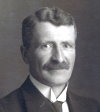 |
|
University of Copenhagen, and was curator at the Botanical Museum of the University of Copenhagen 1905-18, and head of the museum 1918-1920. From 1920 to 1947 he was a professor of botany at the Danish College of Pharmacy. He studied the Danish flora, vegetation of the Danish West Indies, plankton of the North Atlantic and Mediterranean, and the flora of Central Asia. He participated in marine biological expeditions to the West Indies in 1895-1896, and co-authored a work on the flora of the Danish West Indies. He was on expeditions to Northern Persia and Pamir |
1898-1899. He also sailed with the Thor 1903-06 and 1908-09, and with the Dana in 1928. When the Danish Commission for the Exploration of the Sea was started in 1902, he was appointed an assistant at the Plankton Laboratory where he continued to work until 1916. In 1929 he was an instructor in marine investigations in Spain, where he published a report on the microplankton of the Mediterranean. From 1931 to 1946 he was chief of the Plankton Laboratory. He was one of the visiting European scientists who joined the International Phytogeographic Excursion for all or part of its route across the United States and subsequently described the biome zonation from east to west in a paper. Along with Jacob Peter Jacobsen of the Danish Hydrographic Laboratory, Dr. Paulsen in 1910 devised an apparatus for the measurement of plankton in a water sample. This instrument was easier to use and less subject to "operator" error than the preceding model. Two years after his death, his Observations on Dinoflagellates was published. He also published Studies on the vegetation of the Transcaspian lowlands in 1912 which was released in a dozen subsequent editions, and Studies in the Vegetation of Pamir in 1920, and helped to edit parts of the five-volume classic scientific work on flora and vegetation of Iceland entitled The Botany of Iceland. (Photo credit: Geni)
-
pauper'culus: poor, of poor appearance, diminutive of pauper, "providing little."
-
Paxisti'ma: from the Greek pachys, "thick, stout,"
and stigma, "stigma," in reference to the somewhat thickened stigma of the flower. The genus Paxistima was published by Constantine Samuel Rafinesque in 1838.
-
payet'tii: named for Serge Payette (1943- ), Canadian biologist and ecologist, prolific author and professor of biology
 |
|
at Laval University. He was born in Montreal and was awarded a baccalaureate degree in agronomy in Quebéc City in the early 1960s, concentrating mainly on soil studies. He then completed a second degree in geography, as he said “to broaden my horizons.” It was during his geography education that he first went to the far north as a specialist in soil studies for the new Center for Nordic Studies of Laval University. He received a master's degree in plant biology and then went to France where he got a doctorate in natural sciences from the University of Montpellier. He has |
spent some 40 years in research in the northern parts of Canada. He became intensely involved in using dendrochronology to study such things as forest fires, precipitation history, and animal migration routes. He has been a pioneer in Arctic and tundra tree-line ecology. He has been studying forest boundary dynamics and one of his main concerns has been the melting of the tundra’s permafrost which not only destabilizes ground surfaces and threatens the integrity of road and land indrastructures but also releases a huge amount of carbon and methane into the atmosphere. Global warming is largely responsible for this phenomenon and the release of these gases causes global warming to increase. As a botanist he is also the curator of the Louis-Marie Herbarium at Laval University and will soon be publishing with several colleagues the first of four volumes of the Flore du Quebéc Labrador, a much anticipated work. This long-term project, run jointly by the Center for Nordic Studies and the Louis-Marie Herbarium, was initiated by Professor Payette himself in the 1980s. The quality of his research has also been recognized on many occasions. Named Killam fellow by the Canada Council for the Arts between 1989 and 1991, Professor Payette has held one of the six prestigious chairs of the Natural Sciences and Engineering Research Council of Canada since 2003, a national recognition of his accomplishments. scientists. In addition, he is the first recipient of the Weston Family Award, the largest award given to a natural scientist active in northern research in Canada. Despite his many accomplishments, it is teaching that has meant the most to him. (Photo credit: Gouvernement du Quebéc)
-
payne'ae: named for Francis Dorris Payne (Mrs. Alfred Wood Stickney) (1902-1961), biology teacher, botanist and ardent collector of wildflowers. She was born near Alturas, California, and taught at Alameda High School for 30 years until she moved to San Mateo. She collected particularly in Modoc County and found the type specimen of Castilleja payneae on Mt. Warren in the Warner Mts. in 1929. She deposited her collection at the University of California and the California Academy of Sciences. She was a member of the Sierra club and the California Academy of Sciences. She died at Burlingame, California.
-
payne'i: named for Theodore Payne (1872-1963). "Theodore Payne was
born in Northamptonshire, England and
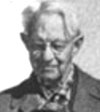 |
|
served an apprenticeship in
horticulture. He came to Los Angeles in 1893 and fell in love with
the California flora, dedicating his life to its preservation. Even
in the early years of this century, native vegetation was being lost
to agriculture and housing at an alarming rate. He urged the use of
California native plants and lectured across the state on preserving
the wild flowers and landscapes native to California. In his own nursery
and seed business, which he started in 1903, native wildflowers and
landscapes were his specialty. In 1915 he laid out and planted 262 species in a |
five-acre wild garden in Los Angeles' Exposition Park.
He later helped to establish the Blaksley Botanic Garden in Santa
Barbara, planted 178 native species in the California Institute of
Technology Botanic Garden in Pasadena, helped create the native plant
garden at Los Angeles' Descanso Gardens, and advised the Rancho Santa
Ana Botanic Garden in Orange County. By the time he retired in 1958,
Payne had made over 400 species of native plants available to the
public." (From the website of the Theodore
Payne Foundation). "Theodore Payne was just 21 when
he arrived at Modjeska Ranch in 1893. He had come from England and
ended up in Santa Ana at a seed store when he heard of the need for
a gardener for the great actress on her ranch in Santiago Canyon.
He decided to take the position even though he had been told it was
a wild place. Since he did not know exactly what he had gotten himself
into he purchased a hand gun and set out for El Toro on the Train.
Years later, in 1962, he was to write his memoirs in Life on the
Modjeska Ranch in the Gay Nineties and speaks of the Ranch in
terms of endearment. He spoke of Arden as a fascinating place with
such lovable people to be associated with. Besides the natural beauty
of the scene, he said the whole air seemed charged with gaiety and
romance. He stated sometimes he wondered if it were not all just a
beautiful dream. This wonderful little book is out of print at the
present time and the copyright is owned by the Theodore Payne Foundation.
The Helena Modjeska Foundation is in touch with them to see if it
would be possible for this to be reprinted. In the meantime, you will
find it in all the local libraries. [Used copies are available by
doing a book search at abebooks.com] Matilija poppies were growing
in this area when Mr. Payne lived on the Ranch. He tried valiantly
to grow them at the request of Mr. Bozenta, as he called him. He was
not successful and it wasn't until later that he learned if he had
burned some straw or dried grass over the ground, he would have been
successful in germinating the seed.. The poppy fascinated him, and
in later years he collected the seed for exporting to Europe."
(From website at http://www.canyonlife.com/STORY2.HTM).
In Theodore Payne's own words: "I was born at Manor Farm.,
Church Brampton, Northamptonshire, England, June 19, 1872, being the
fifth of a family of six boys. My father died when I was less than
three years old, so I do not remember much about him, but he and my
mother had planned and planted a very beautiful garden. As a child
I was passionately fond of flowers; I always found the first primroses
to bloom in the spring. I knew all the haunts of the wild flowers
in the neighborhood. My mother was fond of flowers and had studied
botany; she taught me the names of the plants. I used to collect seeds
of the different flowers in the garden and put them in packets for
friends. I had my own little garden in which I worked and took a great
deal of pride. So it became generally understood while I was still
quite young, that when I grew up I would be a horticulturist. My early
education was at home. We had one small room set aside as the school
room, and a governess came in every day to teach us. The first one
was Miss Tarry who came from a neighboring village. She did not have
much success with me, I did not want to learn, I would much rather
work in my garden or play out in the farm yard. She almost gave me
up as hopeless. Then she left and Miss Warren took her place. We got
along well, and I began to make some progress. My mother died when
I was eleven years old and when I was twelve I was sent to Ackworth
School in Yorkshire. It was Quaker boarding school and the school
where my older brothers and also my father had gone before me. At
Ackworth I joined a natural history society. While being interested
in natural history generally, botany was my special choice and I was
elected secretary of the botanical section. My collection of pressed
wild flowers was awarded the first prize. It was here at Ackworth
that I had my first lesson in conservation. A rare plant which had
been known in only one locality had become almost extinct. Our natural
history society obtained some roots from another source and we planted
them in the place where they were becoming extinct. There was a limited
number of gardens for boys who were interested in horticulture. You
could obtain the rights to one of these gardens by buying it from
some other boy who was willing to relinquish his claim or who leaving
school at the end of the term. Mine was handed down to me by my brother.
I took great interest in this garden and had a fine display of flowers
especially perennials. After leaving Ackworth, I was apprenticed for
three years to the firm of John Cheal & Sons, Lowfield Nurseries,
Crawley Sussex, to learn the nursery and seed business. The guardians
of my father's estate paid a premium of fifty pounds (about $250)
to this firm for teaching me the business. My indenture of apprenticeship
was drawn up legally, signed by all parties before witnesses, and
bore government stamps for the amount of fifty shillings. The firm
paid me five shillings (about $1.25) a week for the first two years
and six shillings a week for the last year. I went through all the
different departments of this business, viz. Greenhouse department,
growing plants under glass, propagating under glass, grafting rhododendrons,
clematis, etc. Budding roses in the field both bush and tree types.
Budding and grafting fruit trees, pruning and training fruit trees,
espalier, cordon, bush and standard. Propagating ornamental trees
and shrubs, layering, etc. Propagating perennial and rock garden plants."
(An excerpt from the forthcoming In His Own Words by Theodore
Payne quoted from the Theodore Payne Foundation website) (Photo credit: Wildflowering LA)
-
payson'ii: named for Wyoming botanist and professor of botany Edwin Blake Payson (1893-1927). He was born at
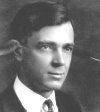 |
|
Norwood, Colorado, and graduated from the local high school. About that time he had aquired copies of P. A. Rydberg’s Flora of Colorado (1906) and Aven Nelson’s New Manual of Rocky Mountain Botany, and he began collecting and corresponding with Nelson at the University of Wyoming, who encouraged him to begin his college botany work at UW and provided him a subsidy to collect during the summer of 1913 on the nearby Uncompahgre Plateau. He collected again in the summer of 1914 near his father’s cattle ranch at Naturita, Colorado, and then in 1915 |
he met J. Francis Macbride who had been unhappy in his botany studies at Harvard, and Payson took him on a collecting trip to the Grand Canyon and West Coast. The following summer a joint Harvard-Wyoming sponsored collecting trip took the two budding botanists east from Boise, Idaho and down through the Sawtooth Mountains, bringing back a mass of material including a new genus, eventually named Anelsonia. He received his BA degree from the University of Wyoming in 1917. That year also saw him marry another botany student and the outbreak of World War I. Before Payson’s departure for military service he had been awarded a teaching fellowship at the Henry Shaw School of Botany, Washington University, St. Louis. Nelson assured him that upon completion of his graduate work at Washington University, he would have a position in the Wyoming botany department. Sergeant Payson remained in Europe at the end of the war and was an instructor in botany at the American Expeditionary Forces University in Beaune, France, in the spring of 1919, but by the end of the year he was back in St. Louis, gaining a Master’s degree in 1920 and a doctoral degree in 1921. He became an associate professor of botany at the University of Wyoming from 1921 to 1925 and then a full professor. During the summer of 1923 he had suffered a debilitating illness that possibly resulted from a tick bite, but as time passed he recovered. He was considered a brilliant botanist with a great future ahead of him, specializing in the families Brassicaceae and Boraginaceae. The summer of 1926 saw him collecting extensively in the Uinta Mountains of Utah, and then, during a meeting at the International Botanical Congress in Ithica, New York in August, 1926, he suffered an attack that appeared to be a minor stroke. Doctors in Denver diagnosed and began treatment for a curable neuritis. Aven Nelson had arranged for him to receive a Guggenheim fellowship to enable him to collect on the Danish Faroe Islands and to study at the Royal Botanic Gardens, Kew. His teaching continued in the spring of 1927 but he returned to Denver for reexamination and the rediagnosis was a non-functioning gall bladder. It and his appendix was removed but following the surgery he died unexpectedly at the age of 34. He was the first monographer of Lesquerella, and had published articles in American Journal of Botany, Botanical Gazette, Contributions from the U. S. National Herbarium, Annals of the Missouri Botanical Gardens, and the University of Wyoming Publications in Botany. His death was a great shock to Nelson who had assumed that Payson would be carrying on his work, and it was a great loss to western botany. (Photo credit: Hunt Institute for Botanical Documentation)
-
pearson'ii: named for William Henry Pearson (1849-1923), British author of Hepaticae of the British Isles. He was interested in bryology from an early age and followed the lead of his mentor Benjamin Carrington, a liverwort specialist. Carrington and Pearson issued the first of their Hepaticae Britannicae Exsiccatae in 1878, and Pearson continued to issue sets after Carrington died in 1893. He joined the Moss Exchange Club in 1908, and was elected an honorary member in the same year. He was elected vice-president of the newly formed British Bryological Society in 1923. Pearson also took interest in ferns and alpine flowering plants. William Henry Pearson was born at Pendleton, near Manchester, Lancashire, the eldest child of Thomas Pearson, sub-manager at a printing works. After leaving school, Pearson went to work for a firm of yarn agents in Manchester, and eventually set up in the same line of business in Manchester on his own account. In 1882 he married Annie Dearden. They lived in Eccles during the late 1880s and early 1890s, where Pearson met and befriended Carrington, whose medical practice was in the town and where he also taught a botany class. By 1901 William and his family had moved to Knutsford, and by 1911 he had moved to Withington, a suburb of South Manchester, where he lived for the remainder of his life. Pearson died at his home in Manchester on April 19, 1923, and was buried in the Southern Cemetery there. His herbarium is at the Natural History Museum in London, with additional plants at Bolton Museum in Manchester. 100 of his Welsh liverworts were sold to the National Museum of Wales at Cardiff in 1913. Manchester Museum has bryophytes that he collected from 1878 onwards. Pearson’s obituaries in the Manchester Guardian and Manchester City News relate that he was particularly noted for his climbing, literary and botanical interests. This information is largely quoted from an article by Mark Lawley, and I thank him for it.
-
pechoen'sis: of or from the area of the Pecho Hills, southwest of
San Luis Obispo.
-
peckia'na/peckia'num/peck'ii: named for Morton Eaton Peck (1871-1959), field botanist, professor of botany at
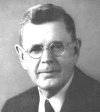 |
|
Willamette University in Salem, Oregon, and author of A Manual of the Higher Plants of Oregon. He was born near LaPorte in Iowa the son of an avid naturalist and taxidermist, and attended local schools before going to Cornell College in Mt. Vernon, Iowa, gaining a classical education and graduating with an AB in 1895, but soon turning to the natural sciences and especially to botany, no doubt influenced by his father. He commenced teaching at small colleges in Missouri (Marionville Collegiate Institute) and Iowa (Ellsworth College and Iowa Wesleyan University), was married in |
1905, and received an AM degree from Cornell in 1911. The Oregon University website says “During his tenure at [Ellsworth] College, his expeditions included a float trip down the Mississippi River, a train ride to New Orleans, and passage on a United Fruit Company steamer to British Honduras. He also journeyed to Belize with his new wife, Jessie Grant, a former botany student.” He collected birds, mammals, plants and slime molds. Many of the specimens were later purchased by Eugene S. Ellsworth for the Natural History Museum at Ellsworth Community College which was founded in 1890 in Iowa Falls, Iowa. He also received honorary doctorates from Cornell in 1940 and from Willamette University in 1955. He accepted a position as a professor at Willamette University in 1908 where he was the only biology teacher in the school and was later chairman of the biology department, remaining there until his retirement in 1941. During this time he conducted botanical field trips to areas from Cape Lookout on the Oregon coast to the Three Sisters near Bend. The Oregon Encyclopedia further says: “His knowledge of the flora of the Wallowa, Steens, and Cascade ranges, Lincoln Constance wrote, was ‘incomparable’ and was achieved after often difficult travel by foot or horseback in remote areas. Peck's expertise in floristics, taxonomy, and phytogeography are evident in his Manual of the Higher Plants of Oregon and the Peck Herbarium of Willamette University (WILLU), which honors his extensive collections. Many praised his floristic manual for its format and lightweight size, its phylogenetic keys, new records, and thorough descriptions of plants and physiographic provinces. Arthur Cronquist, a well-known systematist and eventual director of New York Botanical Garden, noted that Peck’s collection of Oregon plants was ‘the most complete, so far as I know that exists.’ Three years before his death in 1959, Peck characterized the herbarium as the ‘sole interest to which I have a modicum of energy remaining to devote...for which I daily feel indebted.’ " His wife, Jessie Grant Peck, accompanied him on collecting trips and was an instructor of biology and a herbarium assistant at Willamette University. His health began to fail in 1952 and he was twice before his death in 1959 incorrectly pronounced as having passed. (Photo credit: Oregon Encyclopedia)
-
pec'ten-vener'is: Venus comb.
-
Pectian'tia: from Latin pecten or pectinis, "a comb," and anti, "opposite, opposing, set against," referring to stamens opposite to petals. The genus Pectiantia was published by Constantine Samuel Rafinesque in 1836.
-
pectina'cea: same as following entry.
-
pectina'ta/pectina'tum/pectina'tus: comb-like, from Greek peko, "to comb."
-
pectinif'era: bearing a comb-like structure.
-
pectinisec'ta: from the words for "comb" and "cut,"
so presumably meaning cut in the fashion of a comb.
-
Pec'tis: from the Greek pecteo, "to
comb," the leaves of most species being pectinately ciliate,
that is, fringed with hairs on the margin with narrowly close set
divisions like the teeth of a comb. The genus Pectis was published by Carl Linnaeus in 1753.
-
Pectocar'ya: from the Greek pectos,
"combed," and karua, "nut," because of
comb-like margins on some of the nutlets. The genus Pectocarya was published by Augustin Pyramus de Candolle in 1840.
-
pecuniar'ia: possibly from the Spanish pecuniaria, "financial,
pecuniary or related to money," from the Latin pecuniarius,
"of money". David Hollombe has informed me that this taxon
was found beside Dollar Lake.
-
peda'ta/peda'tum: like a bird's foot, with divisions
radiating from a single point.
-
pedemonta'na: Stearn gives "of Piedmont, Italy" as the
meaning of this name, and perhaps it does mean that in the case of other taxa, but I think for this particular taxon, the meaning
derives rather from pes or pedis, "a foot, the
base of anything" and montana, "pertaining to mountains,"
and thus "at the base of the mountains." This taxon inhabits
the foothills of the Sierra Nevadas. Another ssp. of G. capitata is mediomontana, "in the middle elevations of the mountains."
-
pedicella'ta/pedicella'tus: from the
Latin for "with a pedicel" because of the thread-like stalks
of the flower.
-
Pedicular'is: from the Latin pediculus meaning "louse," referring to the old English belief that
when cattle grazed on these plants, they became infested with lice. The common head and body louse that typically infect human beings is called Pediculus humanus. The genus Pedicularis was published by Carl Linnaeus in 1753.
-
pediculif'era: bearing lice.
-
Pediomel'um: from the Greek pedion, "a plain or level country," and melon, apple, thus "plains-apple." The genus Pediomelum was published by Per Axel Rydberg in 1919.
-
peduncula'ta: with a distinct stalk, referring
to the prominent flower stems, from the Latin pedunculatus, "peduncle, a flower stem/stalk."
-
pee'blesii: named for Robert Hibbs Peebles (1900-1955). “Robert Hibbs Peebles was an American botanist and
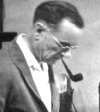 |
|
agronomist who worked for the United States Department of Agriculture. He is known for his contributions to the flora of the American southwest and work on breeding cotton. His 1951 book Arizona Flora, co-authored with Thomas H. Kearney, and republished posthumously in 1960, is recognized as the most comprehensive study of Arizona plants of its time. Peebles named and described over 180 species or variety of plants, often in collaboration with Kearney. Peebles and Kearney also collaborated on cotton breeding, and their contributions to the science of cotton |
growing have been recognized as 'among the most outstanding of all time.' In 1955, Peebles was awarded an honorary doctorate of science from the University of Arizona in recognition of his contributions to Arizona agriculture. Peebles died at the age of 55 in March 1956, the same year in which Kearney died. He was posthumously awarded the Superior Service Award and medal by the USDA.” He was also the co-author of Flowering Plants and Ferns of Arizona (1942).” (Quoted from Wikipedia) (Photo credit: Cactus and Succulent Society)
-
Pega'num: from the ancient Greek name peganon for rue. The genus Peganum was published by Carl Linnaeus in 1753.
-
peirsonia'na/peirson'ii: named for Frank Warrington Peirson (1865-1951), a California collector who worked mostly
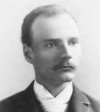 |
|
mostly in the San Gabriel Mountains and Inyo County with his half-sister Mable Burnham Peirson (1876-1966), a high school biology teacher. He grew up in Ithaca, New York, and was educated at Haverford College just outside of Philadelphia, graduating in 1889. He lived in Altadena, California, for most of his adulthood (1902-1951) where his sister also lived (they may have lived together since I have no evidence that either was ever married). He made many collecting trips in the San Gabriel Mountains, and in 1934 spent time on Santa Cruz Island collecting plant |
specimens “with a family member,” likely his sister. He was also known for being one of the first to collect in the Rock Creek basin area of the eastern Sierras. His Rock Creek collecting trips were in the 1930s and early 1940s, and he self-published Plants of Rock Creek Lake Basin, Inyo County, California: A Checklist in 1938, reporting a total of 344 taxa. He also wrote Trees and Shrubs of the San Gabriel Range in 1934. He maintained a private herbarium with extensive collections from the San Gabriel Mountains and elsewhere in souther California that is now housed at Rancho Santa Ana Botanic Garden. His sister graduated from Cornell University in 1900 with a degree in botany and while teaching at the Girls Collegiate School in Los Angeles worked for the summer program at Cornell in 1904.
-
Pelargo'nium: from the Greek pelargos for "stork," alluding to the bill-shaped fruit [Note: It
is interesting that several of the members of this family take their
names from long-billed birds, i.e. pelargos (stork), geranos (crane), and erodios (heron)]. The genus Pelargonium was published by Charles Louis L'Héritier de Brutelle in 1789.
-
Pelazoneur'on: the only derivation I know of so far is the root neuron for 'nerve." The genus Pelazoneuron was published in 2021 by Alan Reid Smith and Susan Fawcett.
-
Pellae'a: from the Greek pellaios, "dark,"
possibly alluding to the stalks of this fern which are generally dark.
The genus Pellaea was published by Johann Heinrich Friedrich Link in 1841.
-
Pel'lia: named for (Pietro) Leopoldo Pelli-Fabbroni (1783-1864), an Italian lawyer. He was in Florence and was a friend of Giuseppe Raddi. His father was the naturalist Giovanni Valentino Matteo Fabbroni (1752-1822). The genus Pellia was published by Raddi in 1818.
-
pel'lita/pelli'ta: from the Latin pellis, "skin or hide,"
thus meaning covered with skin-like film or hide.
-
Peltan'dra: from the Greek pelte, "a shield, target,"
and aner or andros, "stamen, man," hence "hidden
or shielded anthers or stamens." The genus Peltandra was published by Constantine Samuel Rafinesque in 1819.
-
pelta'ta/pelta'tum: shield-shaped.
-
pelvifor'mis: from the Latin pelvis, "a basin," thus shallowly cupped or shaped like a shallow bowl or basin.
-
penard'ii: named for Eugène Penard (1855-1954), Swiss biologist and pioneer in systematics of the amoebae. The
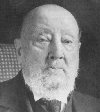 |
|
following is quoted from the website of the Penard Labs, a private a protistology lab in Berlin, Germany, focusing on ameboid protists: "[He] was born on September 16, 1855 in Geneva. His father was a director of a private school in Geneva. Eugène had a brother and two sisters. After finishing college in Geneva (1872) Eugène Penard was trained at a bank where he worked as a cashier. In 1881 he and his parents decided that he should rather become a scientist. Off he went to study Greek, Latin, and natural science at the Universities of Edinburgh and Heidelberg. He |
returned to Geneva in 1882 and became a zoological student of Prof. Karl Vogt (1817-1895). In 1883 he interrupted his studies to work as a private teacher of the young Prince Orlow in St. Petersburg. After returning to Geneva in 1886 he finished his studies and focused on protists. For his work on Ceratium hirundinella he was awarded a doctor of sciences degree from the University of Geneva in 1887. Afterwards he moved to Wiesbaden in Germany to work as a private teacher for the family of Baron Belevski (1887-1890). After returning yet again to Geneva Penard traveled a lot and even stayed in the Rocky Mountains for nearly half a year to collect plants and amoebae. In 1892 he moved back to St. Petersburg as a private teacher. He returned to Geneva with a Russian bride who had also worked as a teacher for Prince Orlov and got married in 1900. The money that he had made as a private teacher allowed the humble Penard now to focus his studies entirely on protists. In 1902 he published Faune rhizopodique du Bassin du Léman and this was followed in 1904 by Les Héliozoaires D'eau Douce. In addition to these major works, Penard published over 90 scientific articles in English, German, and French, mainly about protists. His knowledge of amoebae and heliozoans cannot be overstated. In the year 1922 after having worked for more than 15 years on his book Etudes sur les Infusoires d'eau douce, his eyesight deteriorated rapidly and he was strictly forbidden to use a microscope. Thus at the age of 67, at the peak of his career, his professional life as a researcher was practically over. Penard had described approximately 530 new species, about 60% of them amoebae and heliozoans, and published over 2,300 pages on protists." (Photo credit: Journal of Protozoology)
-
pendletonen'se/pendletonen'sis: named for Camp Pendleton Marine Corps Base in San
Diego County, and applied to the taxa Eryngium pendletonense and Ceanothus pendletonensis.
-
pendleton'ii: named for George Marion Pendleton (1864/1865-1932) who first found this taxon. He was a photographer and a member of the Sullivant Moss Society. Pendleton lived in Sisson (Mt. Shasta), California. The first collections of the species that bears his name were distributed by Carolie Coventry Haynes in her exsiccatae American Hepaticae (number 90) as Jungermannia cordifolia Hook. It was probably through this set that William Henry Pearson became familiar with the plant and decided to describe it as new. In the original description, Pearson wrote on the naming of the species: “I have the pleasure of naming this unique species [Jungermannia pendletonii] after its discoverer, especially as Pendleton, a small town near Manchester, was my birthplace."
-
pendleton'ii: named for Robert Larimore Pendleton (1890-1957), soil scientist and professor of geography. He was
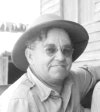 |
|
born in Minneapolis and grew up in California. As an teenager, Pendleton collected 87 plants in the vicinity of Avalon, Pebble Beach, Moonstone Beach, and the Isthmus on Santa Catalina Island. His island plant specimens are in the University of California herbarium. He attended the University of California, Berkeley, and received a bachelor of cience degree in 1914 and a doctor of philosophy in 1917. From 1914 to 1915 he was assistant on the California Soil Survey. He was married in 1917 and later studied at language schools in India and China. During his early career he worked as |
an agriculturist in the Philippines, China, and Siam. Pendleton's field work was mostly in areas of the far east, and he served as soil technologist to the Ministry of Agriculture in Thailand. From 1917 to 1923 he worked as an instructor in soils in India and was director of the Department of Agriculture for the Maharajah of Gwalior, Central India. Other positions he held were professor of soil technology at the College of Agriculture of the University of the Philippines, chief soil technologist and agricnlturist of the National Geological Survey of China 1931-1935, adviser in agriculture and soil technologist with the Department of Agriculture and Fisheries in Siam, member of the Mindanao Exploration Committee in 1939 and the Refugee Economy Corporation, consultant of the US War Department 1942-1944, agriculture adviser with the military geologic unit, Chemical Engineers, US War Department 1944, Principal Soil Technologist of the Office of Foreign Agricultural Relations of the US Dept. of Agricultnre, and adviser to the Siam mission, Food and Agriculture Organization, United Nations. In 1942, Pendleton returned to the US where he was employed at the Department of Agriculture. He was appointed to Johns Hopkins University in 1946 where he was professor of tropical soils and agronomy, and retired as professor emeritus in 1955. In April 1956 he returned to Thailand to become soil technology adviser to the Ministry of Agriculture. He was a member of numerous boards, societies, unions and clubs, and produced numerous publications on the subject of soil science and related subjects. He died in Los Angeles in 1957. ( Lupinus pendletonii) (Photo credit: University of Wisconsin, Milwaukee)
-
pen'dula: same as pendulina.
-
penduliflor'a: with blossoms that "hang
down" as they age.
-
penduli'na: hanging, pendulous, from Latin pendulus, "hanging down," also "doubtful, uncertain."
-
pendulocar'pa: with fruits hanging down.
-
pen'dulum/pen'dulus: hanging down, from the Latin pendere,
"to suspend", the -ulus suffix indicating a tendency
or action.
-
penicilla'ta:
having a tuft of hair somewhat like a paintbrush, from Latin penicillus, "a painter's brush or pencil of hairs."
-
peninsular'e/peninsular'is:
growing on a peninsula; for example, referring to the first collection
of the species Allium peninsulare in Baja California, a peninsula.
-
pennellia'nus: named for Francis Whittier Pennell (1886-1952), American botanist and world authority on the family Scrophulariaceae. He was born as a Quaker near Wawa, Pennsylvania, and was educated at Westtown School and then at the University of Pennsylvania, from which he received a BS degree in 1911 and a PhD in 1913. He wrote his doctoral thesis on the Scrophulariaceae. He was a member of the staff at the New York Botanical Garden from 1914 to 1921, at which time he became curator of plants at the Academy of Natural Sciences of Philadelphia. He engaged in a series of field researches on North American Scrophulariaceae, publishing an important monograph, The Scrophulariaceae of Eastern Temperate North America, in 1935. At the time of his death he was completing a companion volume for the western United States. Outside the United States, his botanical explorations took him to Colombia with Henry Hurd Rusby in 1917 to search for wild stands of Cinchona for wartime supplies of quinine, to Peru and Chile in 1925, and to various parts of Mexico over several seasons between 1934 and 1940. His last mission was to Peru in 1948. He also collected with Lincoln Constance, Arthur John Cronquist, John Thomas Howell, David Daniels Keck, Ellsworth Paine Killip, and Frank Warrington Peirson. He had an intense interest in the history of botany and collected biographical material on many early botanists. He was a member of the American Association for the Advancement of Science, The Botanical Society of America, the Torrey Botanical Club, and the Pennsylvania Botanical Society. In 1942 he served as president of the American Society of Plant Taxonomists, and for many years he was president of the Philadelphia Botanical Club and editor of its journal, Bartonia. He was also the author of The Scrophulariaceae of the Western Himalayas, Scrophulariaceae of the Western Mountain States, The Life and Work of Rafinesque, Travels and Scientific Collections of Thomas Nuttall, Botanical Collections of the Philadelphia local area, and others. He died of a heart attack while attending a Quaker meeting in Media, Pennsylvania. JSTOR lists an E. Pennell and a J.R. Pennell as co-collectors of his, and the Harvard University Herbaria database lists an Elizabeth Pennell (possibly aka Mrs. Edward Pennell), collected 1915, and a James R. Pennell, collected 1920-1929, but whether these individuals were related to him or not I have not been able to determine. His wife's name was Anne Garrett Walton.
-
Pennise'tum: from the Latin penna,
"feather," and seta, "a bristle," thus
literally, "feather-bristled," because some species have
plumose or feathery bristles. The genus Pennisetum was published by Louis Claude Marie Richard in 1805.
-
Pen'stemon: the usual derivation for this name published in many sources including Stearn's Dictionary of Plant Names for Gardeners and Flora of North America is from the Greek penta,
"five," and stemon, "stamen," for the fifth
stamen, referring to the staminode, and alluding to the fact
that it has five stamens, but this appears to be not exactly the case. One piece of evidence that this might have been true is that the genus name was spelled at one time, apparently incorrectly by Linnaeus, Pentstemon, which would correspond with the root penta. But John Mitchell's original publication in 1748 had the spelling that we are now familiar with, Penstemon, and a number of people such as Francis Whittier Pennell, Walter Fertig and others have opined that the “pen” in Penstemon comes not from penta ("five") but from the Latin paene meaning “nearly” or “almost,” while stemon comes from the Greek for “thread.” Fertig in an online USDA Forest Service article on Rydberg's penstemon says “ Nearly a thread is a reference to the staminode, which is almost a functional stamen." So both derivations have to do with the stamens, and particularly the fifth stamen, but the root words are different. A well-presented summary of how this etymology came to be is provided in Al Schneider's excellent website Wildflowers, Ferns and Trees of Colorado, New Mexico, Arizona and Utah and is presented here with only minor adustments: “From his plant collections in Virginia, the well-known botanist (and cartographer, zoologist and physiologist) Dr. John Mitchell described and named a new species which he placed in a new genus, Penstemon. In 1748 he published the new species and genus. A few years later Linnaeus described this new plant in his famous 1753 Species Plantarum. However, Linnaeus renamed Mitchell's new plant Chelone pentstemon, placing the plant in an already existing genus, changing Mitchell's spelling of Penstemon to pentstemon, and making pentstemon the specific epithet, not the genus. The rules of the modern International Code of Botanical Nomenclature indicate that no plant names or descriptions are valid if they were published before 1753, the date of Linnaeus' Species Plantarum. Mitchell published the genus name Penstemon in 1748, so it is not valid. Since Linnaeus placed the plant Mitchell discovered in the genus Chelone, there is no publication of the genus name Penstemon in Linnaeus' 1753 Species Plantarum. In his 1762 Icones Plantarum (Illustrations of Plants, page 2), Casimir Schmidel published a description of the Penstemon genus [in 1763], and this is the earliest publication of the new genus name. Schmidel is now accepted as the author of the Penstemon genus name. Schmidel did not, however, describe a particular species in this genus. That description was finally written by the renowned British gardener William Aiton, "Gardener to his Majesty" from 1759 to 1793. In the King's Gardens Aiton grew plants from the seeds of Penstemon plants collected by Mitchell. In his three volume 1789 Catalogue of the Plants Cultivated in the Royal Botanic Garden at Kew, Aiton described these plants and named the species, Pentstemon laevigata. This species is the accepted type specimen of the genus. The accepted spelling of the name is now Penstemon laevigatus. Most botanical floras indicate that the word Penstemon is derived from the Greek pente, "five," and stemon, "thread.” It is stated that Penstemons are so named to point out that they have five stamens (thread-like structures) and/or to draw attention to one of the five stamens, the one that is sterile and distinctly different from the others. This derivation would be supported by Linnaeus' spelling of the genus name, Pentstemon. However, the genus name was not spelled Pentstemon by Mitchell or Schmidel, and it is not now the accepted spelling. A more accurate etymology of the name Penstemon is therefore the one given by the prestigious Intermountain Flora: pen (or paene) is Latin for "nearly," and stemon, for "thread.” The genus name thus means "nearly a thread", i.e., that there is one structure that is nearly a stamen.”
-
pensylvan'ica/pensylvan'icum: of or from Pennsylvania.
-
Pentachae'ta:
from the Greek penta, "five," and chaeta,
"bristle or long hair," referring to the five pappus scales.
The genus Pentachaeta was published by Thomas Nuttall in 1840.
-
pentac'tis: five-rayed, from penta, "five," and actis, "a ray or beam."
-
Pentagram'ma: possibly from two Greek words
meaning "five stripes," penta, "five." and gramme, "a mark or line." The genus Pentagramma was published by George Alfred Yatskievych, Michael D. Windham, and Eckhard Wollenweber in 1990.
-
pental'epis: five-scaled.
-
pentan'dra/pentan'drum: with five stamens.
-
pentasper'ma: five-seeded.
-
peplo'ides: means "resembling Peplis (now Lythrum) portula" and describes the appearance
of the plant when it grows on exposed mud, rather than under water.
-
pep'lus: this is one that I'm still puzzling
over. One source has peplum as a garment worn by women in ancient
Greece, which was cloth caught at the shoulders and draped in folds
to the waist, and another gives peplis as a name used by Dioscorides
for a Mediterranean coastal spurge and peplus as a name he used
for the northern equivalent of peplis. The taxon in California with this epithet is Euphorbia peplus, most commonly called petty spurge, but also cancer weed and radium weed.
-
per-: sometimes used as an intensive prefix meaning "well,
very much, completely," also through, all over, during, throughout or by.
-
peramoen'us: very pleasing.
-
Peraphyl'lum: from the Greek pera, "excessively,"
and phyllon, "leaf," thus "very leafy." The genus Peraphyllum was published in 1840 by Thomas Nuttall.
-
percaul'is: a 2013 article by Guy Nesom about Erythranthe percaulis says that this name derives from per, "exceedingly," and -caulis, 'stemmed.'
-
peregri'na/peregri'num/peregri'nus: foreign
or exotic, wandering or straggling in growth.
-
peren'nans: perennial, from the Latin per meaning "through" and annus meaning "year," referring to the perennial nature of the species.
-
peren'ne/peren'nis: perennial, from Latin perennis, "everlasting," from the Latin suffix per-, "all over, during, throughout," and annus, "annual."
- perex'ilis: very slender, from per, an intensive meaning "well, very much, completely," and exilis, from the Latin for "small,
thin, slender, feeble."
-
Pere'zia: named for Lorenzo Pérez, a 16th century Spanish apothecary, writer on materia medica, and author of a history of drugs in 1575. The genus Perezia was published by Mariano Lagasca y Segura in 1811.
-
pere'zii: named for Jorge Victor Pérez (1869-1920), a physician and horticulturist
from the Canary Islands.
-
perfolia'ta/perfolia'tum: refers to a leaf which has its margins entirely surrounding the stem in such a fashion that the stem seems to pass through the leaf.
-
perfora'tum: perforated, with the paired leaves joined at the base
and thus 'perforated' by the stem.
-
Perical'lis: from the Greek perikalles, "very beautiful."
The genus Pericallis was published by David Don in 1834.
-
periclymeno'ides: resembling genus Periclymenum. Periclymenum is a Greek word for a honeysuckle.
-
Peric'ome: from the Greek peri, "around," and come,
"a tuft of hair," referring to the ciliate akene margins.
The genus Pericome was published by Asa Gray in 1853.
-
Periderid'ia: either from (1) the Greek peri, "around," and dere, "the neck," from
the involucre (Jepson and other sources), or from (2) the Greek peri,
"around," and derris, "a leather coat,"
(Munz). Derris also means in Greek fur, hair-cloth, a
leather covering, and could be an allusion to the tough seed pods. The genus Perideridia was published by Heinrich Gottlieb Ludwig Reichenbach in 1837.
-
perinci'sum: from the Latin per-, a prefix meaning "very much, completely," and incisus, 'cut,' referring to the leaflets especially of the upper leaves that are deeply incised.
-
Perit'oma: from the Greek for "cut-around," peri meaning "around" and tome or tomos meaning
"division, section, to slice." The calyx base is circumscissile.
The genus Peritoma was published by Augustin Pyramus de Candolle in 1824.
-
Perit'yle: from the Greek peri, "around,"
and tyle, "a callus," and meaning "around the
margin," referring to the thick calloused margin of the achenes.
The genus Perityle was published by George Bentham in 1844.
-
peritylo'ides: like genus Perityle.
-
perpal'lidus: very pale, from per, "very," and pallidus, "pale."
-
perplexa: from the Latin meaning "entangled. involved, intricate, confused."
-
perplex'ans: intricate, involved, puzzling,
tangled.
-
Per'sea: from the Greek name persea used by Theophrastus and
Hippocrates for some unknown Egyptian tree, possibly Cordia myxa. The genus Persea was published by Philip Miller in 1754.
-
per'sica: from the Latin persica, "peach,"
in ancient times called persike or persica malus, "Persian
apple," a fruit that reached Europe from China by way of Persia.
-
Persicar'ia: the medieval name of a knotweed, from Persica,
"peach," alluding to the shape of the leaves. The genus Persicaria was published by Philip Miller in 1754.
-
persicario'ides: resembling Persicaria, whose generic appellation
is derived from the medieval name of a knotweed.
-
per'sicus: belonging to, of or from Persia.
-
persis'tens: persistent.
-
persona'tus: from the Latin personatus, "masked."
-
persson'ii: named for Nathan Petter Herman Persson (1893-1978), Swedish physician, botanist and bryologist. The following is an obituary written by Alan Cyril Crundwell and Elsa Nyholm in the Journal of Bryology, Vol. 11:2, 1980: “He was born in Goteborg, of a family of well-to-do builders. As a schoolboy, influenced by an aunt who was keen on botany, he became interested in the local flora and also took up the study of bryophytes, though he had no personal contact with any other bryologists. While still a student at Uppsala University he published two papers on the results of his bryological activities. He took his first degree in science (including some botany) in 1915, and then studied medicine, completing his studies in Stockholm in 1924. After qualifying he worked for a short time in a tuberculosis sanatorium, but found medical life not to his taste and for many years had no paid work, devoting his time to botany as an amateur. In 1939 he became curator of the bryophyte herbarium at the Botanical Garden at Goteborg. In 1941 he moved to Stockholm and was in charge of the bryophyte herbarium at the Riksmuseum until his retirement in 1963, and he continued to work there on a part-time voluntary basis until his death. His botanical interests, though concentrated on mosses and liverworts, were not confined to them, and he also worked on the taxonomy of Leontodon and other apomictic [asexual] flowering plants. His earlier bryological work was mainly of a local Swedish floristic nature, but in 1937 he broadened his horizons by a long collecting trip to the Azores. He also visited Madeira and the Canaries and published several papers on the bryophytes of Macaronesia [four volcanic archipelagos in the North Atlantic, off the coasts of Africa and Europe]. Probably he is best known for his work on arctic bryophytes, especially those of Alaska about which he published many papers, though he never set foot there himself. In 1956-1957 he spent a year at Stanford University, California, working with William Campbell Steere on Alaskan mosses, and on a visit to the Queen Charlotte Islands was the first to discover Takakia in North America. His work was mainly floristic or concerned with the solution of taxonomic problems in single species or small species groups, and he never wrote any monographs or published anything in book form. As a taxonomist he was careful and accurate. He was very interested in phytogeography, and his discussions of points of difficulty or of special interest were always most valuable. He was always eager to discuss his own bryological problems and to help other people with theirs. In his student days he was a keen athlete, but for many years he had trouble with his back, the result of a fall, and this latterly made him very bent. All his life he was subject to periods of acute depression, yet he was a most entertaining and lively companion, with an enormous stock of amusing anecdotes that he loved to retell. He took immense trouble over the welfare of the staff who worked under him, many of whom were refugees from the second World War, and he earned the gratitude and affection of all of them. He married in 1933. His wife, Gurli, who accompanied him on many of his travels, died in 1972.”
-
perstric'tus: a modern Latin dictionary says this is the perfect
participle passive of the transitive verb perstringo, "to
graze or touch lightly," also with the meanings "to belittle
or censure," or "to dull or deaden (senses)," but none
of these may explain its botanical meaning which is more likely to
derive from strictus, "upright, stiff," and the intensive
prefix per-, thus meaning "very stiff or very straight."
-
peruvia'num: of or from Peru.
-
-pes: a suffix referring to the stalk, see brevipes, latipes, longipes,
ternipes.
-
pes-cap'rae: means "foot of the goat,"
alluding to the shape of the leaflet.
-
Petalon'yx: from the Greek petalon,
"petal," and onyx, "claw," thus claw-petalled.
The genus Petalonyx was published by Asa Gray in 1854.
-
Petalos'temum: from the Greek words for "petal" and "stamen"
because of the unusual union of these parts, this is a genus whose
only southern California representative, searsiae, has now
been placed by Jepson into the genus Dalea. The genus Petalostemum was published by André Michaux in 1803.
-
petasa'ta: probably from the Latin petasatus, "prepared
for a journey, having a cap on."
-
Petasi'tes: a Greek name derived from petasos, "a hat
with a broad brim," alluding to the large leaves. The genus Petasites was published by Philip Miller in 1754.
-
petasi'tis: hat-like.
-
Peter'ia: named for Robert Peter (1805-1894), a Kentucky botanist and
chemist, "...born in Launceston, Cornwall,
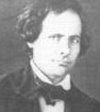 |
|
England, 21 January, 1805. He
received his earliest education principally in England, and subsequently
by self-instruction. About 1817 he came to the United States and settled
in Pittsburgh, where he became an assistant to Charles Avery, a wholesale druggist, and learned the drug business. While so engaged
he devoted much attention to botany, and to the conchology of the
rivers, also founding a botanical society, and becoming associated
in the organization of the Philosophical Society and the Philological
Institute of Pittsburgh. In 1828 he became a naturalized |
citizen of the US. At the invitation of Amos Eaton, he attended a 12-week session at Rensselaer School (now Rensselaer Polytechnic Institute, Troy, New York,
in 1828, where he received the title of Lecturer on Natural and Demonstrative
Science. In 1829 he opened his own drug store, and around that same time he was invited to deliver experimental lectures
on chemistry at the Western University of Pennsylvania, and also at
the Mechanics' Institute in Pittsburgh. In 1832 he delivered a course
of chemical lectures at Peers Eclectic Institute of Lexington, Kentucky,
and was engaged to assist in the chemical instruction of the medical
department of Transylvania University, also becoming professor of
chemistry in Morrison college of that university. He then entered
the medical department, was graduated with an MD degree in 1834, and was married in 1835 to Francis Paca Dallam, with whom he would have eleven children. He only practiced for three years, preferring botany over medicine, and in 1838 was appointed
professor of chemistry and pharmacy in that institution. In 1839 he
visited Europe in order to secure books, anatomical preparations,
and apparatus for the university, and at the same time he attended
lectures in Paris and London. He was associated in founding the Kentucky
School of Medicine at Louisville in 1850, but three years later returned
to the Medical School of Lexington. During the greater part of the
civil war he was employed as acting assistant surgeon in charge of
the United States general hospitals in Lexington. In 1865 he was appointed
professor of chemistry and experimental natural philosophy at Kentucky
University, which in 1866 acquired the Agricultural and Mechanical
College of Kentucky, in which he remained until 1887, when he was
made emeritus. Dr. Peter was chemist to the Kentucky Geological Survey
in 1854-1860, and in 1859-1860 conducted the chemical department of
the geological surveys of Indiana and Arkansas. This work was interrupted
by the civil war, but resumed in 1875, and since that year he again
filled the post of chemist to the Kentucky Geological Survey. In this
capacity he accomplished numerous analyses of soils, ores, waters,
and other materials which were published in the reports of the surveys.
He edited the "Transylvania Medical Journal" in 1837-1838,
and besides many articles on chemistry, geology, and medicine, in
periodicals and the transactions of societies of which he is a member,
he prepared the 'Geological Formations of Kentucky' for
Collins's History of Kentucky. [Other publications of his were]
'A Digest of the Report of the Geological Survey of Arkansas'
and a 'Digest of the Reports of the First Geological Survey of
Kentucky,' prepared under the auspices of the United States Geological
Survey." (Quoted from Virtual
American Biographies). The genus Peteria was published by Asa Gray in 1852. (Photo credit: Eastern Kentucky University)
-
petiolar'e/petiolar'is: with conspicuous petioles, not sessile.
-
Petrador'ia: from the Greek petra, "a rock," and Doria, an early name for the goldenrod, named for Andrea Doria (1468-1560), admiral of the Republic of Genoa. The genus Petradoria was published by Edward Greene in 1895.
-
petrae'a/petrae'us: rock-loving.
-
petro'phila/petro'philus: from the Greek petros, "rock,"
and phileo, "to love," because of its habitat.
-
Petrophy'ton: from the Greek petra,
"rock," and phyton, "plant," thus rock
plant. The genus Petrophyton was published by André Michaux in 1803.
-
Petrophy'tum: see above. The genus Petrophytum was published by Per Axel Rydberg in 1900.
-
Petrorha'gia: from the Greek petros,
"rock," and rhagas, "a chink or break"
from rhegnymi, "to break asunder," thus meaning "rock
fissure" in reference to the habitat of some species. The genus Petrorhagia was published by Johann Heinrich Friedrich Link in 1831.
-
Petroseli'num: from the Greek petros, "a rock,"
and selinon, "parsley or celery," this is the name
used by Dioscorides, although the Jepson Manual curiously says "stone
wreath." Several sources say that the name refers to the plant's habit of growing in rocky places, and Wiktionary gives it the name of rock parsley. The genus Petroselinum was published by John Hill in 1756.
-
Petu'nia: from petun, a native American name for tobacco. The genus Petunia was published by Antoine Laurent de Jussieu in 1803.
-
Peucephyl'lum: from the Greek peuke,
"fir," and phyllon, "leaf," because of
its superficial resemblance to a fir tree. The genus was published by Asa Gray in 1859.
-
Pha'ca: Dioscorides' name for a legume. The genus Phaca was published by Linnaeus in 1753, and he almost certainly took the name from Dioscorides' de Materia Medica.
-
Phace'lia: based on the Greek phakelos,
meaning "cluster," and alluding to the densely crowded flower
spikes of most species of the genus which was published by Antoine Laurent de Jussieu in 1789.
-
phaeacan'tha: from the Greek root phae- or phaios meaning "dusky, dark or gray" and acanthos,
"spine," thus dark- or gray-spined. Thanks to Philippe
Faucon at Desert-Tropicals.com for information regarding this name.
-
phaeocar'pa/phaeocar'pum/phaeocar'pus: with dark fruit.
-
phaeoceph'ala/phaeoceph'alus: with dark
heads.
-
Phaeocer'os: Wikipedia says "Its name means 'yellow horn', and refers to the characteristic yellow spores that the plants produce in the horn-shaped sporophyte. The genus Phaeoceros was first recognized in 1951 by Johannes Max Proskauer. The type species is Phaeoceros laevis, commonly called smooth hornwort,
-
Phalacros'eris: from the Greek phalakros, meaning "bald,"
and seris, "a species of chicory or endive." The genus Phalacroseris was published by Asa Gray in 1868.
-
Phalar'is: an ancient Greek name used by Dioscorides
for a kind of grass with shiny spikelets, according to Umberto Quattrocchi
from phalaros, "having a patch of white, crested,"
and/or phalos, "shining, bright, white." The genus Phalaris was published by Carl Linnaeus in 1753.
-
Pharna'ceum: named for Pharnaces II (97-47 BC), an ancient monarch of Greek and Persian ancestry. He was the youngest child born to King Mithridates VI, King of Pontus and Armenia Minor, and his first wife, his sister Queen Laodice. Born and raised in the Kingdom of Pontus, he was the namesake of his late double great grandfather Pharnaces I of Pontus. Although ancient historians referred to him as Pharnaces of Pontus, he did not actually rule the Kingdom of Pontus. After his father was defeated by the Romans in the Third Mithridatic War (73–63 BC) and died in 63 BC, the Romans annexed Pontus, merged it with the former Kingdom of Bithynia and formed the Roman Province of Bithynia and Pontus. His life, like his father's, was basically spent in various military actions mostly against the Romans. He was King of the Cimmerian Bosporus or the Bosporus Kingdom, a region bordering on the Black Sea and the Sea of Azov. He was finally defeated by Julius Caesar, sailed back to the Cimmerian Bosporus to recover it from Asander who had been left in charge there but had revolted. Caesar's forces had killed all his horses and he was defeated and killed by Asander's troops. His daughter and her family succeeded him as ruling monarchs of the Bosporan Kingdom. The genus Pharnaceum was published in 1753 by Carl Linnaeus who had a great interest in Greek and Roman history.
-
Phaseo'lus: from the Greek phaselos, "a little boat or
light vessel," referring to its similarity to a bean pod, this
name became the Latin phaseolus used for a kind of bean. The genus Phaseolus was published by Carl Linnaeus in 1753.
-
Phelipan'che: from the related genus Phelipaea and anchone, "choke or strangle"
because of a parasitic habit. The genus Phelipanche was published in 1874 by Auguste Nicolas Pomel.
-
Phelypae'a: named for Louis Phélypeaux de Pontchartrain (1643-1727) and his son Jérôme Phélypeaux de
 |
|
Pontchartrain (1674-1747), both French politicians. Louis was born and died in Paris. His father, Louis Philippe Phélypeaux, like him was the Comte de Pontchartrain, a commune in the Île-de-France region in north-central France approximately 35 kilometres from Paris. After serving as head of the Parlement of Brittany, a court of justice under the Ancien Régime in France, he held office as Controller-General of Finances and as Navy secretary, and from 1690, secretary of state of the Maison du Roi (household of the king). Wikipedia says: “Long considered a failure, his reputation has been reevaluated by recent historiography which has shown that, in a period of difficulty, he was a capable administrator of an immense department which had responsibility for the French Navy, trade, colonies, matters of religion, Paris, the royal household and for finances. Nonetheless, his handling of the French Navy, a powerful force under Jean-Baptiste Colbert and his son Jean-Baptiste Antoine Colbert, Marquis de Seignelay, was criticized, and he was considered to be in part responsible for the defeat at the battles of Barfleur and La Hougue in 1692. He conducted a census |
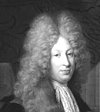 |
of the population from 1693 onward, the first since Sébastien Le Prestre de Vauban's of 1678. Phélypeaux served as Chancellor of France from 5 September 1699 to 1 July 1714. Historian François Bluche wrote that 'he gave the Chancellor's office an importance and authority not seen since the early years of Pierre Séguier.' Saint-Simon painted a flattering portrait of Phélypeaux in his diaries, and his discretion was appreciated by Louis XIV. He was made clerk of the prestigious Order of the Holy Spirit in May 1700. He resigned in 1714 for having failed to affix the seals to the decree of 5 July 1714, condemning a document by the Bishop of Metz, Henri-Charles de Coislin, as contrary to the papal bull Unigenitus. He had found it difficult to reconcile his religious beliefs with those of the increasingly authoritarian Louis XIV. He retired to an Oratorian institution where he died in 1727.” His son, Jérôme, directed a significant programme of explorations and encouraged the settlement and development of Louisiana. He was responsible for the creation of the Académie des Inscriptions et Belles-Lettres. He served with his father as secretary of state of the Maison du Roi and Navy Minister from 1699 onwards. In 1715, with the death of Louis XIV and the assumption of power by the Regent, Phélypeaux was compelled to resign his ministries in favour of his son Jean-Frédéric. Effective authority, and later the guardianship of his children, passed to his kinsman Louis Phélypeaux, marquis de La Vrillière. The genus Phelypaea was published by Carl Linnaeus in 1758.
- phenicodon'ta: one of the meanings of the the Greek root pheno- is purple-red, and -odon is a root for tooth. This is a new epithet in the California flora applied to Encelia farinosa var. phenicodonta. There are two recognized naturally-occurring varieties, Encelia farinosa var. farinosa with yellow disc florets and Encelia farinosa var. phenicodonta with purple-brown disc florets, which probably accounts for the varietal name.
-
-phila/-philum: from phileo, "to love," this is
an ending which conveys the sense of loving some particular habitat
or other, as in eremophila, "desert-loving," nemophila,
"loving a glade or wooded meadow," or psammophila,
"sand-loving" or halophilum, "salt-loving."
-
philadel'phica/philadel'phicus: of or from Philadelphia.
-
Philadel'phus: a Greek-derived name for Ptolemy II Philadelphus (308-246 BC), Macedonian Greek King of Egypt
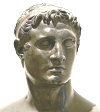 |
|
from about 283 until his death in 246 BC. He was born on the Isle of Kos (Cos), the son of one of Alexander the Great’s generals, Ptolemy I Soter, who founded the Ptolemaic Kingdom, a Hellenistic kingdom based in ancient Egypt and ruled by the Ptolemaic dynasty, which started with his accession after the death of Alexander the Great in 323 BC and ended with the death of Cleopatra and the Roman conquest in 30 BC. His reign was significant in many ways. He promoted the museum and the great library of Alexandria, he developed agriculture and commerce, engaged |
in skillful diplomacy, and made Alexandria a leading centre of the arts and sciences. Dynastic strife resulted in the banishment of his first wife, Arsinoe I, daughter of King Lysimachus of Thrace, following which he married his sister Arsinoe II, widow of Lysimachus. He was the first Pharoah to marry a full sister, but the tradition became standard for the Ptolemies. He began his reign as co-regent with his father in 285 BC and was sole ruler in 283/282. Although he was successful in prosecuting the so-called First Syrian War against Antiochus I, the Seleucid king who was trying to expand his empire's holdings in Syria and Anatolia, the Second Syrian War against Antiochus II did not go so well, and a substantial naval defeat lessened Ptolemy’s power. The war ended upon the marriage of Antiochus to Ptolemy’s daughter, and both men died in 246, the former possibly poisoned by his previous wife Laodice. The material and literary splendour of the Alexandrian court was at its height under Ptolemy II. Pomp and splendor flourished. He had exotic animals of far off lands sent to Alexandria, and staged a procession in Alexandria in honor of Dionysus led by 24 chariots drawn by elephants and a procession of lions, leopards, panthers, camels, antelopes, wild asses, ostriches, a bear, a giraffe and a rhinoceros. According to scholars, most of the animals were in pairs - as many as eight pairs of ostriches - and although the ordinary chariots were likely led by a single elephant, others which carried a 7-foot-tall golden statue may have been led by four. Ptolemy was very interested in both Greek and Egyptian religion, and and spent large sums erecting temples. Ptolemy undertook a great deal of building work throughout Egypt. He enlarged the shrine of Renenutet at Medinet Madi, built a gate between the temple of Imhotep and the temple of Isis on Philae, made additions to the temples of Elephantine and Thebes, left his mark on the temple of Sobek at Medinet el-Fayyum and built a new main temple at Koptos. He also completed the great lighthouse of Alexandria (also known as Pharos) and ordered the construction of a number of cities along the red sea coast (along with numerous temples and canals) which helped to strengthen trade links with the Mediterranean and boost the Egyptian economy. Pliny the Elder also reported that he established a trade link with India, probably with the emperor Ashoka as he is mentioned in the Edicts of Ashoka. He reformed both the tax systen and the system of coinage. He deified both his parents and his sister-wife. He was a generous patron of poets, artists and scholars. He also financed the museum, a research centre where learning included philosophy, literature, mathematics and the natural sciences. Ptolemy reformed the judiciary and promoted royal law above Egyptian and Greek law. He created three distinct courts: the Chrematistai was the royal court and heard cases on an ad hoc basis; the Dikasteria heard cases involving Greek speaking parties; and Laokritai heard cases involving parties who spoke Egyptian and was overseen by Egyptian priests. Informal disputes were still handled outside the courts under Egyptian law with no state interference. Thus while there was a clear aim to centralise control of the legal system, Ptolemy also respected local traditions and much of the reform may in fact have been a codification of the existing situation. He died in Alexandria and was succeeded by his very capable son, Ptolemy III Euergetes. The genus Philadelphus was published by Carl Linnaeus in 1753.
-
philbrick'ii: named for Ralph Nowell Philbrick (1934-2017), botanist at the Santa Barbara Botanic Garden and
 |
|
collector on the Channel Islands. In 1967 he edited The Proceedings of the Symposium on the Biology of the California Islands. From 1974 to 1987 he was the director of the SBBG. He was born in San Francisco and settled in the Pasadena area with his family after the birth of his younger brother. The family had an avocado ranch in Fallbrook where he spent weekends and summers. He graduated from high school in Pasadena and attended Pomona College where he developed an interest in botany, graduating in 1956 and going on to earn a master’s degree at UCLA and a |
PhD in botany from Cornell University in 1963 where he also worked as a research associate at the Bailey Hortorium. He was appointed to a teaching position at UC Santa Barbara and then began working at the Santa Barbara Botanic Garden as a taxonomist. His obituary in the Santa Barbara News-Press says: “While at the botanic garden, Ralph's botanical interests focused on the flora of the California Channel Islands. He made many collecting trips to the islands as well as those off the coast of Baja California, Mexico. He co-authored numerous botanical publications on the islands, established the first California Islands Symposium in 1965, and launched a new, larger island section at the botanic garden. In 1973, Ralph became director of the Botanic Garden and held that position until 1987. Under his leadership, the Garden's education, outreach, and plant breeding programs expanded. Scientific research on the California Islands led to the garden's eventual recognition as a center for island research. The library, herbarium, and living collections grew substantially during his tenure, as did its acreage. Ralph had a keen interest in the aesthetics of the garden grounds and was responsible for several horticultural selections from the islands. Ralph also served as a planning commissioner for Santa Barbara County from 1981 to 1987. After he left the garden, he started a biological consulting business, conducting botanical surveys, and preparing reports for local projects. He moved to the San Marcos Trout Club in 1983 and enjoyed living close to nature in his rustic handcrafted cabin. Ralph was an outdoor enthusiast, cyclist, and avid runner. He began competing in local runs in his mid-40s and he never lost his enthusiasm and passion for the sport. He continued to train hard and run races up until his last year. He was well-known and respected in the Santa Barbara running community and he inspired many younger runners with his drive, hard work to achieve his goals, and determination to be the best he could be. Ralph also had a strong interest in writing and dabbled in both prose and poetry. He authored a vast number of short pieces on a wide variety of topics. Many of his writings reflected his long-time interest in the history of people and places. He spent many years researching the genealogy of his family and writing stories about his findings.” The Santa Barbara Independent said about him: “After leaving the Botanic Garden in 1987, Ralph continued his botanical research along the Baja and Alta California coasts. His name can be found on plant checklists completed for Santa Barbara Island in 1993, Todos Santos and San Martin islands of Baja California in 1994, and San Benito and Natividad islands of Baja California in 2002. Just before he died, he finalized an annotated checklist of the flowering plants and ferns of Anacapa Island. In both his professional and personal life, Ralph will be remembered as a man who, every day, did his absolute best to make the world a healthier, more peaceful, and more beautiful place. He inspired all who knew him.” He died July 10, 2017. (Photo credit: Santa Barbara Independent)
-
Philiber'tia: named for Jean Charles Philibert Legendre (1757-1821?), former advisor to Parliament who for some reason appears to have gone by the name Philibert. From 1797 to 1805 he published six works under the name Philibert, five of which were on botany. He was the son of Jean Gabriel Legendre. The genus Philibertia was published in 1819 by Karl Sigismund Kunth.
-
phillippia'na: named for Rudolph Amandus Philippi (1808-1904), German-Chilean paleontologist and zoologist.
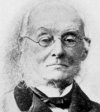 |
|
An article in Malacogia described him as "one of the most important, yet overlooked malacologists of the 19th century." He was born in Charlottenburg, a western suburb of Berlin. When he was ten his family dissolved due to an indiscretion committed by his father, and Rudolph and his brother were taken by their mother to Yverdon, Switzerland, to be educated. He was clearly interested in the natural world even at that early age and made collections of plants and butterflies there. They returned to Berlin in 1822 where Rudolph studied at the Königliche Gymnasium zum Grauen |
Kloster, a school equivalent to a high school. In 1826 he began at the University of Berlin, graduating in 1830 after coursework in botany, entomology, comparative anatomy, vertebrate zoology and biogeography (taught by Alexander von Humboldt). Although his degree was ostensibly in medicine and surgery, he never practiced as a physician. After graduating he spent a year and a half travelling around Italy at least some of the time in the company of two geologists. They studied volcanoes at Etna and Vesuvius and Philippi made collections of fossil molluscs in Sicily. In February 1835 he was hired as a teacher in natural history at the Höhere Gewerb-Schule (equivalent to a teacher’s college) in Cassel, a small university town in northern Germany long known for its natural history museum, the Ottoneum, founded in 1832, which is among the oldest such museums in Germany. In 1836 he published his first major work, Enumeratio Molluscorum Siciliae. He was awarded gold medals by the Kaiser both for his first edition and for his revised and enlarged second edition. In 1836 he was also one of the founders of the Natural History Society in Cassel and was its first director. Because of health concerns he returned to Sicily the following year where he continued his malacological studies. After having been told that he had only a few years left to live, he fully recovered. The 1840s were a very productive period in his life, with numerous publications including the second edition of his work on molluscs and descriptions of new species. His brother Bernhard had joined the German Merchant Marine in 1830 on a round-the-world trip and among other places stopped in Chile. On a second trip in 1832 he decided to stay in Chile and spent several years collecting specimens there and in Peru for sale to natural history museums in Berlin and elsewhere. In 1841 he returned to Chile and was there for the remainder of his life. The Revolution of 1848 was underway in Europe, and Rudolph Philippi was forced to leave Germany. He was invited to Chile by his brother who worked for the government there. He moved to Santiago in 1851. There, he became a professor of botany and zoology and the director of the natural history museum, and was a regular collaborator with Christian Ludwig Landbeck. Philippi described three new species of South American lizards. Regrettably his brother was killed by the natives the year after Rudolph’s arrival, his nephew Theodor, who had become a botanist and a schoolteacher in Concepcion, died from an ulcer in 1852, and his wife died in 1867 of dysentery. Philippi himself became the most significant and prolific naturalist in Chile in the 1800s, and became the director of the Lyceum (high school) in Valdivia in 1853. Later that same year the president of Chile appointed Philippi to be the professor of zoology and botany at the Universidad de Chile (Santiago), and that same month also appointed him to serve as director of the Museo de Historia Natural, which was then located at the university. He was then chosen to be the leader of an expedition to explore the vast Atacama Desert, which was spread across three countries, Chile, Peru and Bolivia, where he made significant geological observations, including the first description of the giant meteor crater there. He spent most of the next several decades focusing on the plants, insects and vertebrates of Chile. He received numerous awards from the German government and in 1890 was given an honorary doctorate from the University of Berlin. He described over 2,500 species of molluscs, over 3,000 species of plants, and over 800 species of insects. He published over 40 papers on ornithology and described marine mammal and fish species as well. His youngest son, Federico Philippi, was also a zoologist and botanist, and his grandson, Rodulfo Amando Philippi Bañados, was a zoologist as well. The Museo de la Exploración Rudolph Amandus Philippi in Valdivia was named for him. (Information largely from an article by Alan Kabat at Harvard and Eugene Coan of the Santa Barbara Museum of Natural History entitled "The Life and Work of Rudolph Amandus Philippi," Malacogia 60(1-2):1-30, 2017)
-
philoxero'ides: like or having the form of genus Philoxerus,
in the Amaranthaceae.
-
-philus: a suffix which frequently means loving or having an affinity
for, as in hydrophilus, "water-loving," petrophilus, "rock
loving."
-
phleo'ides: resembling genus Phleum.
-
Phle'um: from the Greek phleos, an ancient
name for a kind of swamp-growing grass. The genus Phleum was published by Carl Linnaeus in 1753.
-
Phlo'mis: from the Greek name phlomis,
for some plant possibly not of this genus. The genus Phlomis was published in 1753 by Carl Linnaeus
-
Phlox: from the Greek phlox, "flame,"
ancient name of Lychnis of the Caryophyllaceae. The genus Phlox was published by Carl Linnaeus in 1753.
-
Phoenicau'lis: from the Greek phoinix or phoinikos,
"purple, red, crimson," or possibly derived from phaneros,
"evident, conspicuous, visible," and kaulos, "stalk
or stem," thus meaning "visible stem." The genus Phoenicaulis was published in 1838 by Thomas Nuttall.
-
Phoe'nix: a Greek name for the date palm, of uncertain meaning. The genus Phoenix was published by Carl Linnaeus in 1753.
-
Pholis'ma: from the Greek pholis, "scale," because
of the scale-like leaves. The genus Pholisma was published by William Jackson Hooker in 1844.
-
Pholis'toma: from the Greek pholis,
"scale," and stoma, "mouth," hence meaning
"scale-mouthed," because of the scales in the throat of the flower.
The genus Pholistoma was published by Nils Lilja in 1839.
-
-phora/-phorum/-phorus: a suffix meaning "to carry or bear, movement"
(e.g. adenophora, "bearing glands," trichophorum, "bearing
hairs," cephalophorus, "bearing heads").
-
Phoraden'dron: from the Greek phor,
"a thief," and dendron, "tree," hence "tree
thief" because it draws nourishment from its host tree. The genus Phoradendron was published by Thomas Nuttall in 1848.
-
Photin'ia: from Greek photeinos for 'shining, bright.' The genus Photinia was published in 1820 by John Lindley.
-
pho'xus: from the Greek phoxos, "tapering,
pointed."
-
-phragma: indicating the presence of some kind of a partition.
-
Phragmi'tes: from the Greek phragma, "a fence or screen,
hedge," hence growing in hedges. The genus Phragmites was published by Michel Adanson in 1763.
-
Phryma'ceae: the website of the Robert W. Freckmann Herbarium at the University of Wisconsin says that the genus name Phryma was "erroneously given by Bauhin as the Latin equivalent of the Greek Phyrama, an inferior grade of the resin of the metops 'tree,' a north African umbellifer. Literally, something mixed and kneaded, dough."
-
Phy'la: from the Greek phyle, "tribe," probably
from the flowers being tightly clustered in heads. The genus Phyla was published by João de Loureiro in 1790.
-
Phyllod'oce: honors the Greek sea nymph
mentioned by the Roman writer Virgil. The genus Phyllodoce was published by Richard Anthony Salisbury in 1806.
-
phylloman'ica: with wild or excessively leafy growth.
-
Phyllospa'dix: from the Greek phyllon, "leaf," and spadix, "a palm frond or palm branch," and the Latin spadix or spadicis, "a palm branch broken off together
with its fruit," referring to the inflorescence, according to
Umberto Quattrocchi. The genus Phyllospadix was published by William Jackson Hooker in 1838.
-
phyllosta'chya: with leafy spikes.
-
Phyllosta'chys: from the Greek phyllon, "leaf,"
and stachys, "a spike." The genus Phyllostachys was published by Philipp Franz Siebold and Joseph Gerhard Zuccarini in 1843.
-
phylloste'gia: from the words for "leaf"
and "a covering."
-
phyl'lus: leaves, foliage.
-
physalifo'lium: with leaves like those of genus Physalis.
-
Phy'salis: from the Greek physalis,
"a bladder or bubble," because of the inflated calyx. The genus Physalis was published by Carl Linnaeus in 1753.
-
physalo'des: bladder-like, from the Greek physo, meaning "bladdery," and alluding to the inflated calyx.
-
Physar'ia: from the Greek phusa or physa, "bellows"
because of the inflated pod. The genus Physaria was published by Asa Gray in 1849.
-
Physocar'pus: from the Greek phusa or physa, "bladder, a pair of bellows" and karpos,
"fruit," thus "bladdery fruit," alluding to the inflated follicles of some species. The genus Physocarpus was published by Constantine Samuel Rafinesque in 1836.
-
-
Phytolac'ca: from the Greek phyton,
"plant," and Latin lacca, "crimson lake, or a red dye"
because of the color in the berries. The genus Phytolacca was published by Carl Linnaeus in 1753.
-
phytolaccifo'lium: with leaves like genus Phytolacca.
|
